
What Is a Ketch Sailboat?

Last Updated by
Daniel Wade
August 30, 2022
Ketch sailboats are a common sight in some areas, and they have numerous handling benefits. But what is a ketch, and how does it differ?
A ketch is a two-mast sailboat similar to a yawl. The mainmast is shorter than a sloop, and the mizzenmast aft is shorter than the mainmast. A ketch usually has a triangular mizzen sail and a triangular or square headsail.
In this article, we’ll cover the general characteristics of a ketch and how to distinguish it from other two-masted sailboats. Additionally, we’ll go over the benefits of the ketch rig and how it compares to the similar yawl rig. We’ll also overview the most common types of ketch sailboats on the water today.
We sourced the information used in this article from sailboat identification guides and rig design diagrams.
Table of contents

General Description of a Ketch Sailboat
A ketch is a two-masted sailboat with a tall mizzenmast mast aft of the mainmast. A key characteristic of Ketch sailboats is that their mizzenmast is shorter than the mainmast.
The mainmast itself is typical and resembles a sloop mast. A ketch has a mainsail and one or more headsails on the mainmast, along with a single mizzen on the mizzenmast.
A ketch can easily be mistaken for a yawl, as these vessels have similar sail arrangements. Ketch sailboats can have square or triangular rigs, depending on the age and specific design of the boat.
A gaff headsail is usually accompanied by a triangular mizzen on a ketch, similar to a schooner.
Ketch Sailboat History
The ketch is a relatively old part of the sailing world. Based on the classic yawl design, the ketch was used extensively for workboats on the New England coast at the height of the sailing era.
Ketch sailboats were robust and easy to handle. They also tracked a naturally straight course due to their mizzen, which was used as a primitive form of self-steering. This was helpful for small fishing boats, as the crew didn’t need to attend to the rudder quite so often.
Ketch sailboats continued working the New England coast well into the era of steam. In the mid to late-1800s, ketch-rigged workboats were still a common sight in coastal areas.
Today, they persist as recreational and cruising sailboats, as their tough and stable rigs are still a practical option for boatbuilders.
Types of Ketch Sailboats
There are many types of ketch sailboats on the water. The ketch is not the most common kind of sailboat, but there are enough of them around to notice once in a while. Ketch sailboats were once utility boats, but they’ve been strictly used for recreational and cruising boats for the last 100 years or so.
The most common kind of ketch is the simple cruising ketch. These sailboats are typically made of fiberglass and resemble other cruising sailboats in almost every way.
Their interior accommodations are the same as a comparably-sized sloop, though cockpit space is limited due to the presence of a mizzenmast and rigging.
The ketch rig is a popular choice for motorsailers, especially heavy-displacement versions. The ketch is a stable design with quite a bit of power due to its additional mast, which allows the mainsail and boom footprint to be slightly smaller. The ketch is also highly controllable, which is great for closed-cockpit sailboats.
The ketch rig is also popular on classic sailboats. Specifically, the gaff-rigged ketch is a common sight in some classic boat circles—particularly on the East Coast of the United States. Wooden ketch-rigged boats were outfitted with both traditional square and modern triangular rigs.
There are a few smaller open-cockpit ketch sailboats around, and these are popular for cruising deeper water—but not far from shore. Open cruising ketch sailboats are usually less than 20 feet long and can be found most often around Chesapeake Bay.
Cutter Ketch Rig
A cutter ketch is simply a ketch rig with additional headsails. Because the mast is in the same position as a sloop, the ketch is easy to rig with additional forward sails. A typical cruising ketch can use a wide variety of headsails, including a spinnaker.
Ketch Vs Yawl
The ketch rig is very similar to the yawl, which also has a tall mainmast and an additional mizzenmast and mizzen aft. The yawl is a much older boat that originated in England or Scotland around the 17th century.
The yawl rig usually has a shorter mizzenmast that’s positioned further aft, as the mizzen boom usually extends beyond the stern of the boat. A ketch mizzen is positioned forward, usually a bit larger and more comparable to the size of the mainsail.
Yawl and ketch rigs are both quite stable. A ketch usually has a bit more power due to its larger mizzen, though the yawl is generally considered to be easier for a single person or a short-handed crew to handle.
Ketch Rig Benefits
There are numerous benefits to the ketch rig, especially when compared to tall Marconi/Bermuda rigs. The primary benefit is that, despite the additional mast and rigging, a ketch is exceptionally easy to handle.
A ketch spreads out its sail area between the headsail, mainsail, and mizzen. The additional mast and sail allow the mainmast to be shortened, which naturally makes the boat easier to control single-handed.
Ketch rigs offer additional precision, as you can adjust three sails independently to optimize performance for any given wind condition. The mizzen is in close proximity to the cockpit, and due to its small size, it’s easy to control.
Ketch rigs can also self-steer to some extent. The mizzen works the same way that a stabilizing sail on a fishing drift boat does and keeps the boat tracking on a straight course with or without constant rudder input from the crew.
The ketch rig also offers a level of redundancy that traditional single-masted sailboats don’t have. This is particularly attractive to long-range cruisers. A ketch has a shorter mainmast, which allows boatbuilders to use stronger materials and maintain the same weight.
A ketch can continue sailing if you lose a mainstay or suffer dismasting, as there’s an additional mast aft that probably won’t also go down. This extra level of safety is useful when conditions are rough, and it also gives you peace of mind when out on the open ocean.
Related Articles
I've personally had thousands of questions about sailing and sailboats over the years. As I learn and experience sailing, and the community, I share the answers that work and make sense to me, here on Life of Sailing.
by this author
Learn About Sailboats
Most Recent

What Does "Sailing By The Lee" Mean?
October 3, 2023

The Best Sailing Schools And Programs: Reviews & Ratings
September 26, 2023
Important Legal Info
Lifeofsailing.com is a participant in the Amazon Services LLC Associates Program, an affiliate advertising program designed to provide a means for sites to earn advertising fees by advertising and linking to Amazon. This site also participates in other affiliate programs and is compensated for referring traffic and business to these companies.
Similar Posts

Affordable Sailboats You Can Build at Home
September 13, 2023

Best Small Sailboat Ornaments
September 12, 2023

Discover the Magic of Hydrofoil Sailboats
December 11, 2023
Popular Posts

Best Liveaboard Catamaran Sailboats
December 28, 2023

Can a Novice Sail Around the World?
Elizabeth O'Malley
June 15, 2022

4 Best Electric Outboard Motors

How Long Did It Take The Vikings To Sail To England?

10 Best Sailboat Brands (And Why)
December 20, 2023

7 Best Places To Liveaboard A Sailboat
Get the best sailing content.
Top Rated Posts
Lifeofsailing.com is a participant in the Amazon Services LLC Associates Program, an affiliate advertising program designed to provide a means for sites to earn advertising fees by advertising and linking to Amazon. This site also participates in other affiliate programs and is compensated for referring traffic and business to these companies. (866) 342-SAIL
© 2024 Life of Sailing Email: [email protected] Address: 11816 Inwood Rd #3024 Dallas, TX 75244 Disclaimer Privacy Policy
15 Surprising Benefits of a Ketch Rig (and 7 Cons)
If you're trying to figure out whether the ketch rig is for you, there are a couple of important factors to consider. In this article, I'll sum up the most important benefits.
What are the benefits of a ketch rig? Since the sail area is divided over multiple sails, the ketch is more easily managed and is great for single-handed sailing. It offers more versatility in sail plan, and is known to handle very well in heavy winds. The ketch rig is an especially effective rig for larger boats (40ft and up).
Just a quick recap: the ketch is a two-masted sailboat that has a mainmast (front) and shorter mizzenmast (aft or back). Both masts carry a mainsail. The sail on the mizzenmast is also called the jigger.
Your mizzensail provides all kinds of benefits. There are some really creative ways to put your mizzenmast to use. Read on to learn what those are.

On this page:
The ideal rig for long-distance offshore cruising, ketches generally perform better in downwind conditions, smaller sails are easier to manage, easier reefing, using multiple sails allows for more control, more versatile sail plan options, you gain a spare sail, more balanced sailing, superior sail plan in heavy winds, comfort over speed, less stress on the rigging, variety of mizzenmast uses, the air rudder, free riding sail at anchor, incredibly fast in right conditions, disadvantages of the ketch rig, in conclusion.
All in all, the ketch rig is widely known as one of the best rigs for long-distance cruising . There are multiple reasons to back up that claim, and we'll go over all of them one by one below. But the most important reason is that the ketch is incredibly comfortable, both in handling, maneuvering, operating, and the ride itself. This increased comfort is largely thanks to the extra sail aft, the mizzensail, which provides a better power balance.
So who's it for?
The ketch is especially great for long-distance cruisers that face rough waters and heavier winds and are short-handed. For example, couples that want to sail around the world together, or liveaboards that go on long holidays or expeditions. It's also a great family cruiser, since you can sail a larger boat without needing additional crew members or having to operate humongous sails.
While with the Marconi rig the main and jib get in each other's way on downwind runs, the ketch rig has far fewer problems. The mizzensail and mainsail can work together seamlessly and are far more efficient with most points of sail, except of course when sailing very close to the wind. But even then, the Bermuda rig and ketch can go neck-to-neck and the gap in performance isn't necessarily enormous. Unless you're a racer, the ketch is a really good alternative to the Bermuda rig, and most people should at least consider it.
The ketch is a very good single-handed rig, especially for larger boats (40ft and up). Using smaller but more sails allows you to have more sail area, while it's still manageable for one person. Also, smaller sails are easier to handle in heavier winds . Splitting up your sail area is just a great way to keep things in check, even with a small crew of just one or two people.
Because you have more (and mostly smaller) sails, reefing becomes easier. There's less stress on the sails, and you can reef down gradually, in phases, moving through your sails one by one. This ensures comfortable reefing and results in less speed reduction.
Another great tip I've read somewhere is that you can even quickly drop your main when the winds come in. Instantly, you're storm proof, while maintaining speed and course.
The ketch rig has three primary sails instead of two. This provides all kinds of benefits, and there are a couple of really surprising ones, which I'll come to later on. But the most important one is that you gain more control. The mizzensail provides more control over your stern.
Also, with the additional sail, you get a lot more trimming options for all conditions, allowing you more precise control for each point of sail and with any wind.
The extra sail also provides more versatile sail plan options. You have a broader operating range. There are more sails to put up with light airs, but also more sails to take down when things get rough. You can reef in all kinds of different combinations, and even take down the main if you have to. Which brings me to my next point.
This provides A LOT of benefits. For example, if you need to perform maintenance on your main, you can simply take it down, and continue sailing without losing control or a lot of speed. The ketch can sail on all points of wind with the main down (or the mizzen or jib). You have a spare sail, which will come in handy.
The mizzensail has a major upside you just won't get with the Bermuda sloop rig. The mizzensail balances the jib.
Sailing "jib and jigger" means just using your mizzen and jib, and leaving the mainsail down.
I've heard that this sail plan is very well-balanced, and allows you to self steer in a way. You could theoretically even use it as an temporary alternative to your autopilot, should it break down.
Thanks to its more balanced sail plan, the ketch rig is a much more comfortable ride in heavier winds, and many sailors praise the ketch for precisely that. Taking down the mainsail, sailing just the jigger and jib, provides a sort of instant storm sail plan that at the same time offers a lot more control than the single stormsail you'd usually put up on a Bermuda rig instead of the mainsail.

I think it's clear by now that the ketch is maybe the ultimate cruising rig. If you value your comfort, the mizzen offers some incredible benefits. The well-balanced output of this rig and the enormous variety in sail trim options allow for a smooth ride in almost all conditions.
However, you do pay a (minor) price for all this luxury: speed. The ketch is inevitably slower than the leaner Bermuda rig. However, on a downwind run, the ketch will still satisfy: there's plenty of sail area to gain some nice momentum.
Reducing sail size means you don't have to put as much stress on the rigging and you could use shorter masts, making them stronger. The difference in mast length isn't huge, but the forces on the mast grow exponentially with length. So a bit shorter mast makes a big difference.
In turn, the stress on the rigging is also reduced, which can lead to less wear, resulting in lower maintenance costs.
Stress on the rigging seems to be the major disadvantage of the Marconi rig.
Another rig that's a bit 'softer' is the gaff rig . The gaff rig is better suited for inland, calm waters instead of long term cruising, but can be another good alternative to the uptight Bermuda. I have written about the advantages of the gaff rig in detail in this article (opens in new tab).
The mizzenmast and sail can act as several things and will be very useful to creative sailors. Some cool examples I've found:
You can use the mizzenmast and sail:
- Using it as a crane to load and unload cargo
- Using it as an air rudder
- Using it as your riding sail at anchor
The mizzen can be a great help in mooring and the likes. Many ketch sailors use the mizzenmast as a type of massive wind rudder, which is a great help when you want extra control under sail. If you learn to use the mizzensail, you gain an additional rudder, which increases control over your stern and can help you maneuver in tight spots.
You can also use the mizzensail as an alternative riding sail at anchor, although it isn't recommended since your sail will wear down due to increased UV exposure.
As I pointed out briefly before, the ketch rig is a bit slower than most Bermuda rigs. However, in the right conditions, it can be incredibly fast, especially with larger boats that run a well-balanced sail plan. If you are able to utilize the additional sail area and find a course with a good point of sail, the ketch rig can really ramp up.
As with anything, there is a price to be paid for all these advantages, and the ketch rig does have some downsides. I thought it would be only fair to touch on them briefly below. However, if you are able to look past these, in my opinion, minor disadvantages, the ketch rig remains a great rig for serious sailors.
They tend to be slower than sloops
The Bermuda rig isn't the most popular rig by chance. It is by far the fastest rig out there.
They can't sail as close to the wind as sloops
Although modern ketches can sail almost as high as sloops, there's a point where sloops are able to go, and ketches can go no further. However, I think that many recreational sailors won't push their rig to its limits, which means the ketch is still a good option to consider.
The mizzenmast takes up space
Extra masts and extra sails do take up additional space, and space is precious on your boat.
Most ketches are old boats
Since it is a less popular rig type, there are fewer ketches made than Bermuda sloops. The apparant result being that ketches tend to be a bit older, and are a bit harder to find.
They will be more expensive
Since there are less available, they will be more expensive - the additional mast and sails will obviously also increase your purchase. And it's my guess that most ketches are owned by people who know pretty well what their boat is worth, so it will be harder to find a good bargain.
Additional rigging
Ketches have a lot of additional rigging you just won't find on your regular Bermuda. An extra mast and main means additional sheets, halyards, stays, and so on.
More or less maintenance cost
I have never owned a ketch and I never had to maintain one, so I just don't know whether a ketch is more or less expensive in maintenance. The additional rigging and sails may drive up the maintenance cost; on the other end, the sails are smaller and maybe won't all need replacing at the same rate, which may reduce maintenance cost. Especially the fact that ketch sailors use their mainsail less will probably be really cost-effective. Also, the reduced stress on the mast and (standing) rigging, may reduce maintenance cost.
If you have more experience or information about the cost of ownership and maintenance cost of ketches, please leave a comment below. I'm always eager to learn.
The ketch is a great rig that provides comfort, versatility, and control while offering acceptable speeds and a large operating range. It's a viable alternative to the Bermuda rig, and is especially interesting for people that want to explore the world's oceans with a small crew. It's easy to handle but will be more expensive initially, although I suspect the maintenance cost of the ketch rig will even itself out.
There you have it, all the advantages and disadvantages of the ketch rig in one neat overview. I hope this was helpful and has provided some insight to help you in deciding whether or not the ketch rig is for you.
Seamus Scanlan
I once owned a “Morgan Giles” barrell built wooden sloop which I sailed in the Gair Loch and the Firth of Clyde: what a lovely wee boat that was ! However, that was some years ago and “Things Conspired” and I lost her … I Perhaps Life has changed for the better and now I dream of owning a “Miller Fifer”30 or 35 foot. She should provide live aboard accommodation, carry me through the canals of Europe and see me challenge the Med. Your article on the advantages of the ketch has has inspired and encouraged me greatly and I am sincerely grateful; thank you so much. Seamus.
Please enjoy a HEALTHY 2021.’
It’s a bit confusing and frustrating that you compare a ketch to a Bermuda. Ketch is a sail PLAN, Bermuda is a sail SHAPE. As is gaff, by the way. That rather beautiful photo you used is a gaff sail ketch rig. It gets confusing to newer sailors and causes a bit of skepticism in your accuracy. Otherwise, a well written article. As an (occasional) author, I’ve found that reading what you’ve written a week or so later in a very different font can dramatically help proofreading. A good friend also can’t hurt.
Fair winds and smooth seas!
I made the newbie mistake of buying a 12m used ketch without a survey as a first boat. It sure seems like it would be neat to have, were I experienced. But lots more reading to do. It seems mine is not just a ketch but I am told it is a cutter ketch because there is a space for a yankee. But I assume that is still expected to be slower than your sloop as referenced above?
in 1976 I purchased a brand new, built-for-me, 35’ Challenger ketch. On April 1, 1977, I moved onto my Challenger, which became her name, with my wife, 8 and 12year old sons who had first sailed the year before in a 1969, used, Cal 29. We lived on the Challenger every year from 1977 until I sold her in 1994. My boys, from day one could sail her in any weather, high or low winds or waves. We all loved her sailing on Lake Ontario, NY and Ontario Canada and the St. Lawrence River and 1000 Island and around Kingston Ontario area for 22 days in 1978 only docking for two nights and at anchor the rest of the time. Challenger, with the sails properly set could sail herself either across or down the lake West to east. My wife would sleep and I would sit up in the bow in the pulpit while she sailed. We oftentimes would fly a big light drifter in light winds and a staysail from the main mast head to the End of the mizzen boom. With 5 sails up we would fly. It was sad to let her go but Florida has lots of shallow water.
I appreciate the article as i am looking and trying to understand all the differences and advantages and disadvantages. have owned sloops and never even though of the different rigs as I felt they may be to complicated. I am to find something for some enjoyable cruising and will most likely always be shorthanded with crewing issues. I also appreciated Rehn comments just to make you think. Thank you! for sharing your thoughts
Gene Rossano
I am Gene. almost 30 years ago I sold my Challenger 35 Ketch that I purchased new in 1976 and had her trucked to Buffalo, NY from California to sail on all of Lake Ontario and into the St Lawrence River and the 1000 islands and some channels and locks and small lakes in Ontario, Canada. My wife and I and 8 and 12-year-old sons moved on her on April 1st 1977 and moved off the Challenger November 1st every year until I sold her in 1994 to move to Florida, the land of miles and miles of very shallow water. We sailed her every week leaving on Thursday or Friday and returning either Sunday, Monday, or Tuesday to head back to our home port of Wilson, NY, or later, St Catherines Marina, located in St Catherines, Ontario Canada. We sailed her in every kind of wind and wave condition that we all felt Challenger could and would take us home safely and well. My wife and my boys helmed her and tended the sails day and night in all conditions with every different sail combination that we possessed.All sails were hanked.
Leave a comment
You may also like, 12 surprising advantages of a gaff rig (and some cons).
Interested in the gaff rig, but unsure whether it's for you? Trying to pick the right sail rig type can be a challenge. In order to help you out, I made this list …

Guide to Understanding Sail Rig Types (with Pictures)

The Ultimate Guide to Sail Types and Rigs (with Pictures)

How Much Sailboats Cost On Average (380+ Prices Compared)

41 Sailboat Cruising Essentials for Long Trips
- BOAT OF THE YEAR
- Newsletters
- Sailboat Reviews
- Boating Safety
- Sails and Rigging
- Maintenance
- Sailing Totem
- Sailor & Galley
- Living Aboard
- Destinations
- Gear & Electronics
- Charter Resources
- Ultimate Boat Giveaway

20 Best Small Sailboats for the Weekender
- By Mark Pillsbury
- Updated: May 24, 2024
In order to go cruising, most of us require a sailboat with a head, a galley, and bunks. The boat, likely a 30-footer and more often a 40-footer, will have electronics for navigation and entertainment, refrigeration if the trip is longer than a coastal hop, an engine for light wind, and, depending on our appetites for food and fun, perhaps a genset to power our toys and appliances.
To go sailing , however, all we really need is a hull, mast, rudder, and sail. To experience the pure joy of sheeting in and scooting off across a lake, bay, or even the open ocean, there’s nothing better than a small sailboat – we’re talking sailboats under 25 feet. You can literally reach out and touch the water as it flows past. You instantly feel every puff of breeze and sense every change in trim.
Some of the boats in this list are new designs, others are time-tested models from small sailboat manufacturers, but every one is easy to rig, simple to sail, and looks like a whole lot of fun either for a solo outing on a breezy afternoon or to keep family and friends entertained throughout your entire sailing season. This list is made up of all types of sailboats , and if you’re looking for a list of some of the best small sailboats for beginners, you’ll find exactly that here.
Any one of these popular boats could be labeled as a trailerable sailboat, daysailer, or even a weekender sailboat. And while most would be labeled as a one or two person sailboat, some could comfortably fit three or even four people.
– CHECK THE WEATHER – The weather changes all the time. Always check the forecast and prepare for the worst case. Safety Tip Provided by the U.S. Coast Guard
Marblehead 22 Daysailer
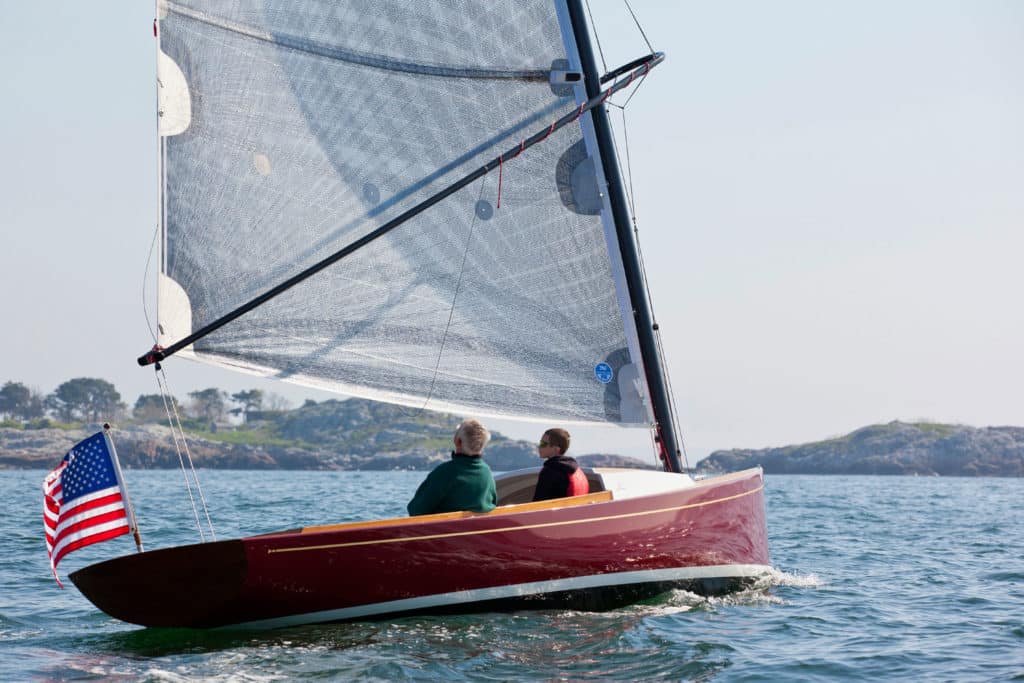
If you have an eye for elegant lines and your heart goes pitter-patter over just the right amount of overhang beneath a counter transom, the Marblehead 22 daysailer, designed by Doug Zurn and built by Samoset Boatworks in Boothbay, Maine, will definitely raise your pulse. Traditional-looking above the waterline and modern beneath, the cold-molded hull sports a deep bulb keel and a Hall Spars carbon-fiber mast with a wishbone rig and square-top main. The 11-foot-9-inch cockpit can seat a crowd, and a small cuddy forward will let you stow your friends’ gear for the day. samosetboatworks.com
Catalina 22 Sport
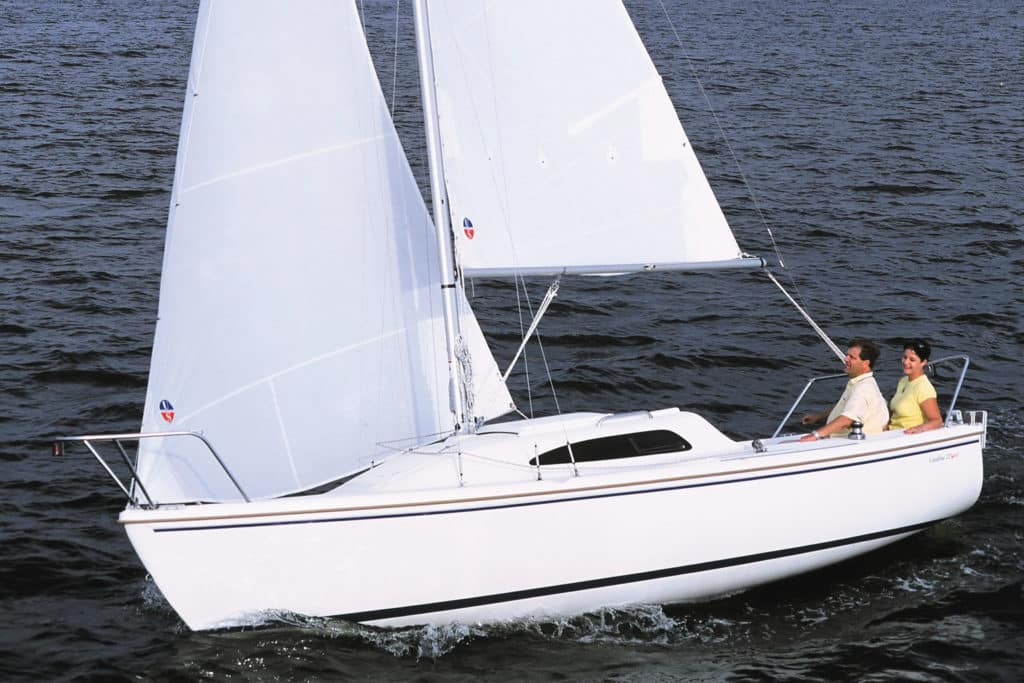
Many a harbor plays host to an active fleet of Catalina 22s, one of the most popular small sailboats over the years, given its basic amenities and retractable keel, which allows it to be easily trailered. Recently, the company introduced the Catalina 22 Sport, an updated design that can compete with the older 22s. The boat features a retractable lead keel; a cabin that can sleep four, with a forward hatch for ventilation; and a fractional rig with a mainsail and a roller-furling jib. Lifelines, a swim ladder, and an engine are options, as are cloth cushions; vinyl cushions are standard. The large cockpit will seat a crowd or let a mom-and-pop crew stretch out and enjoy their sail. It’s clear why the Catalina 22 is one of the best sailboats under 25 feet. catalinayachts.com
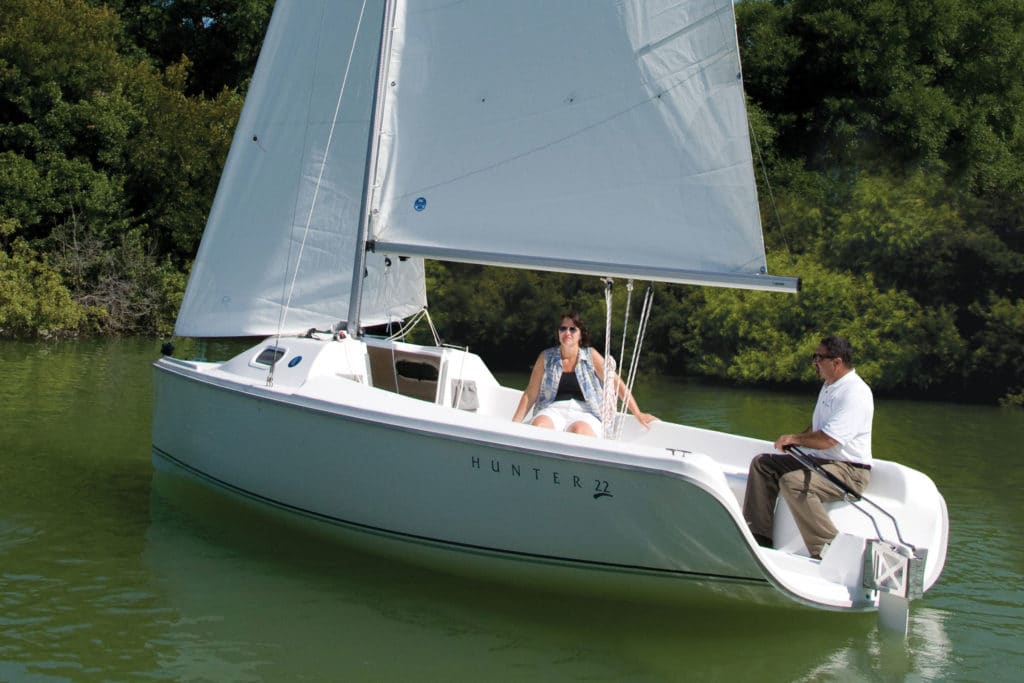
With its large, open-transom cockpit and sloop rig, the Hunter 22 makes a comfortable daysailer for family and friends. But with its cuddy cabin, twin bunks, optional electrical system, opening screened ports, and portable toilet, a parent and child or a couple could comfortably slip away for an overnight or weekend. Add in the optional performance package, which includes an asymmetric spinnaker, a pole, and a mainsheet traveler, and you could be off to the races. The boat features a laminated fiberglass hull and deck, molded-in nonskid, and a hydraulic lifting centerboard. Mount a small outboard on the stern bracket, and you’re set to go. marlow-hunter.com
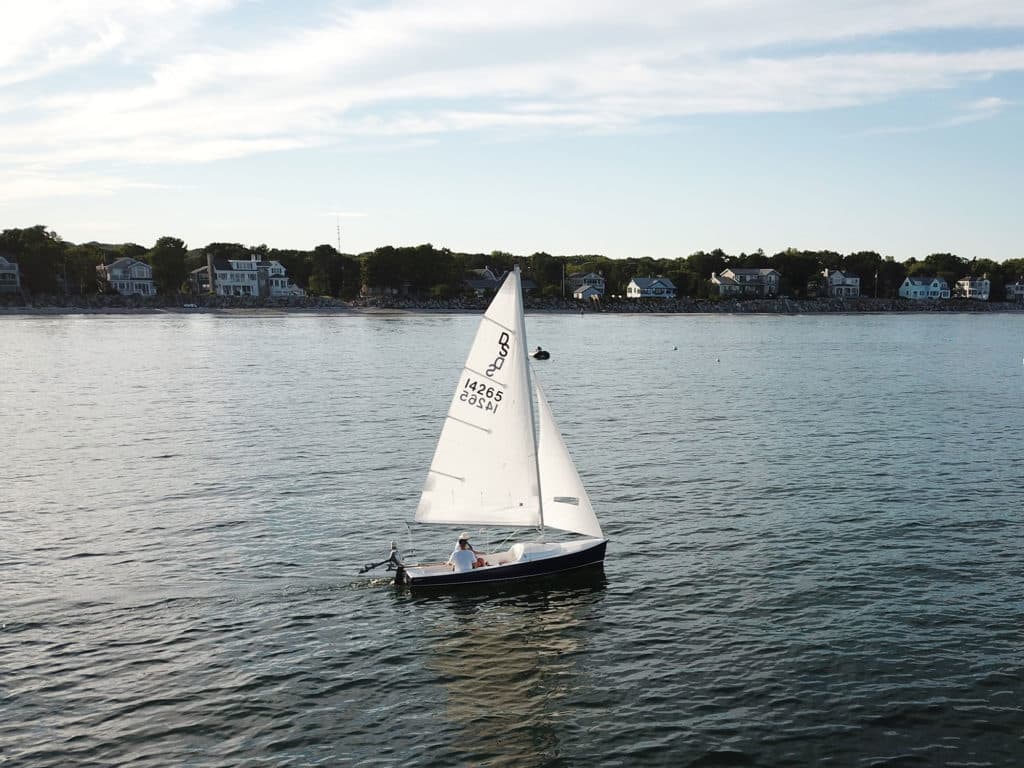
Not sure whether you want to race, cruise or just go out for an afternoon sail? Since 1958, sailors have been having a ball aboard the Uffa Fox/George O’Day-designed Daysailer. Fox, who in the 1950s was on the cutting edge of planning-dinghy design, collaborated with Fall River, Massachusetts boatbuilder O’Day Corp. to build the 16-foot Daysailer, a boat that features a slippery hull and a small cuddy cabin that covers the boat roughly from the mast forward. Thousands of Daysailers were built by various builders, and they can be found used for quite affordable prices. There are active racing fleets around the US, and new Daysailers are still in production today, built by Cape Cod Ship Building. capecodshipbuilding.com
BayRaider from Swallow Boats
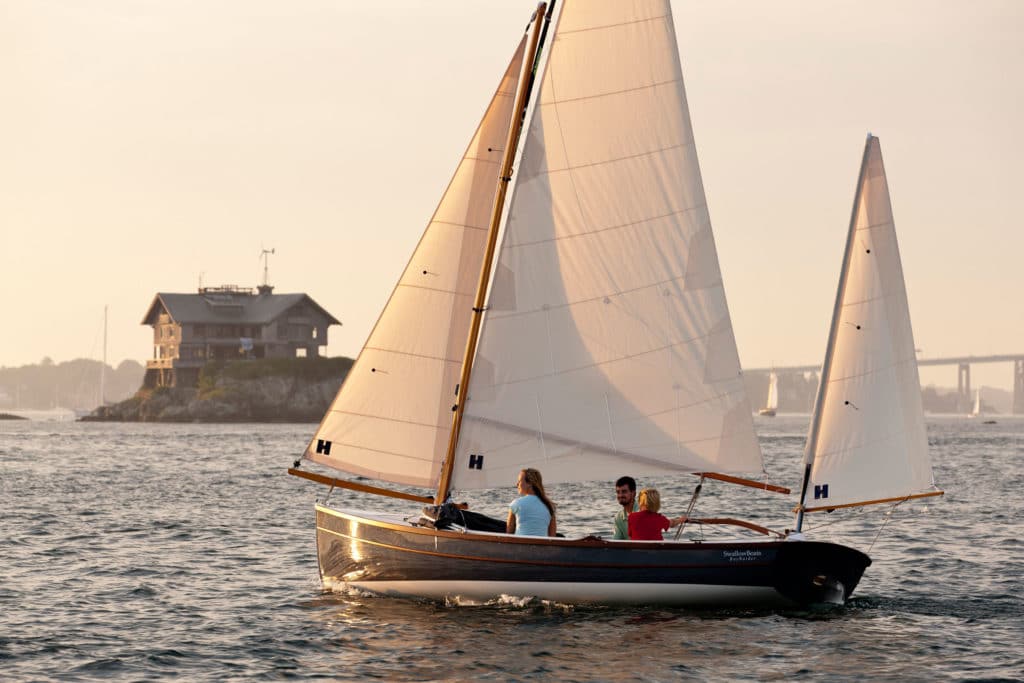
Easy to rig and trailer, the BayRaider from England’s Swallow Yachts is a relative newcomer to the small-boat market in the United States. Nearly all of its 19 feet 9 inches is open cockpit, though a spray hood can be added to keep the forward sections dry. The BayRaider is ketch-rigged with a gunter-style mainmast. The topmast and mizzen are both carbon-fiber, which is an option for the mainmast as well. The BayRaider can be sailed with a dry hull in lighter conditions or with 300 pounds of water ballast to increase its stability. With the centerboard and hinged rudder raised, the boat can maneuver in even the thinnest water.
$28,900, (904) 234-8779, swallowyachts.com
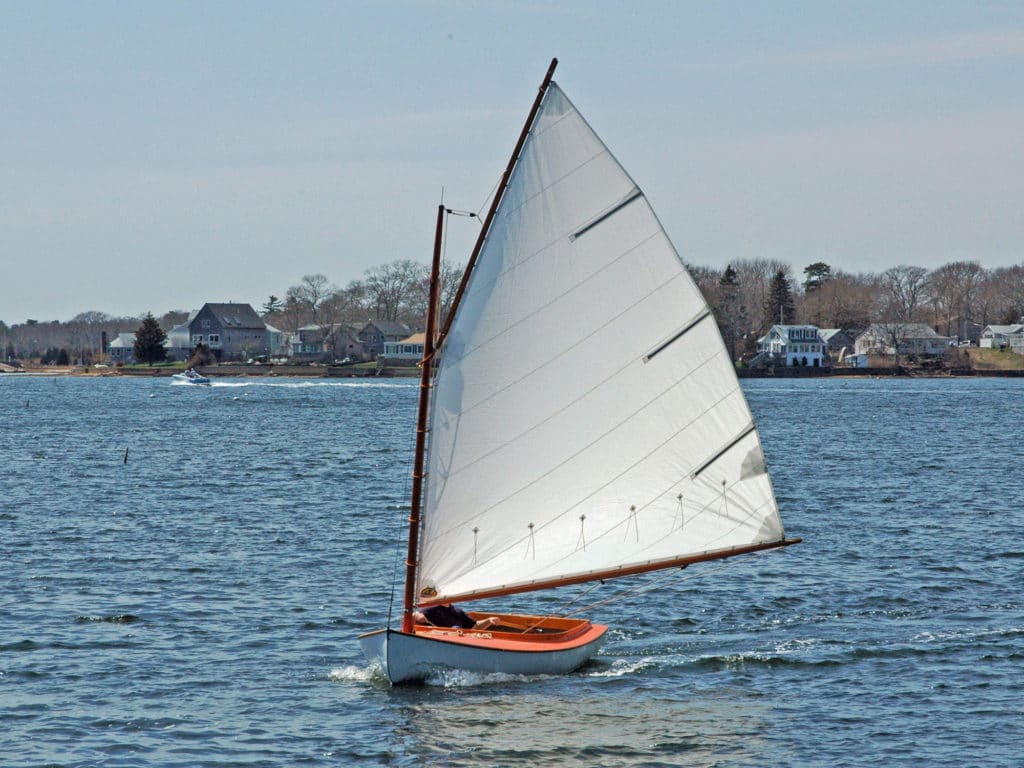
Big fun can come in small packages, especially if your vessel of choice happens to be the 12 ½-foot Beetle Cat. Designed by John Beetle and first built in 1921, the wooden shallow draft sailboat is still in production today in Wareham, Massachusetts at the Beetle Boat Shop. With a draft of just 2 feet, the boat is well-suited for shallow bays, but equally at home in open coastal waters. The single gaff-rigged sail provides plenty of power in light air and can be quickly reefed down to handle a blow. In a word, sailing a Beetle Cat is fun. beetlecat.com
– LEARN THE NAVIGATION RULES – Know the “Rules of the Road” that govern all boat traffic. Be courteous and never assume other boaters can see you. Safety Tip Provided by the U.S. Coast Guard
West Wight Potter P 19
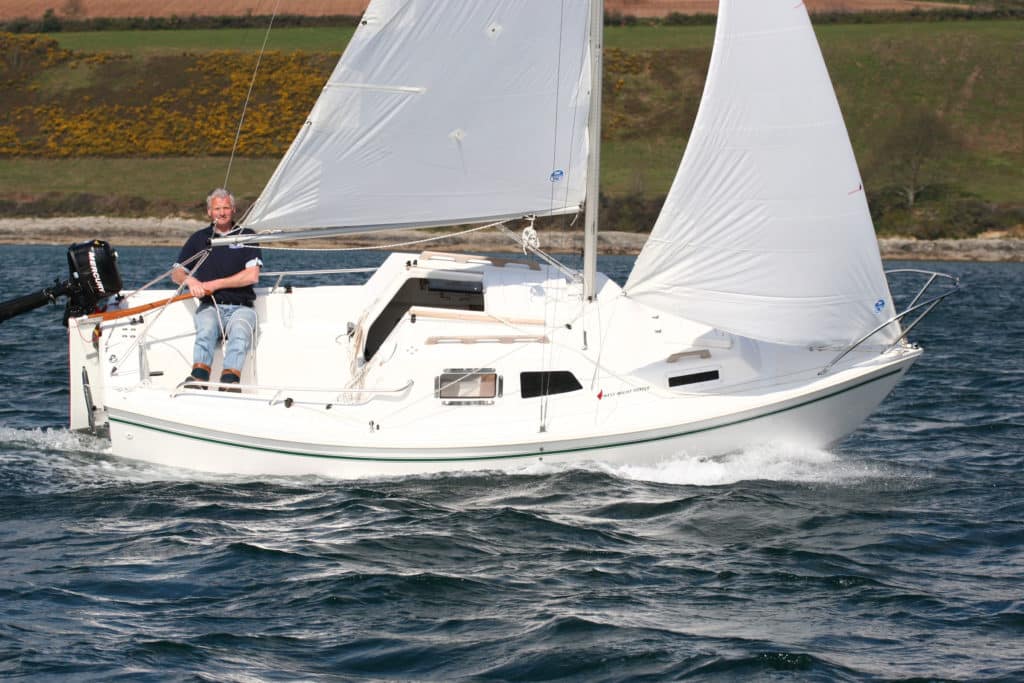
With berths for four and a workable galley featuring a cooler, a sink, and a stove, West Wight Potter has packed a lot into its 19-foot-long P 19. First launched in 1971, this is a line of boats that’s attracted a true following among trailer-sailors. The P 19′s fully retractable keel means that you can pull up just about anywhere and go exploring. Closed-cell foam fore and aft makes the boat unsinkable, and thanks to its hard chine, the boat is reportedly quite stable under way. westwightpotter.com
NorseBoat 17.5
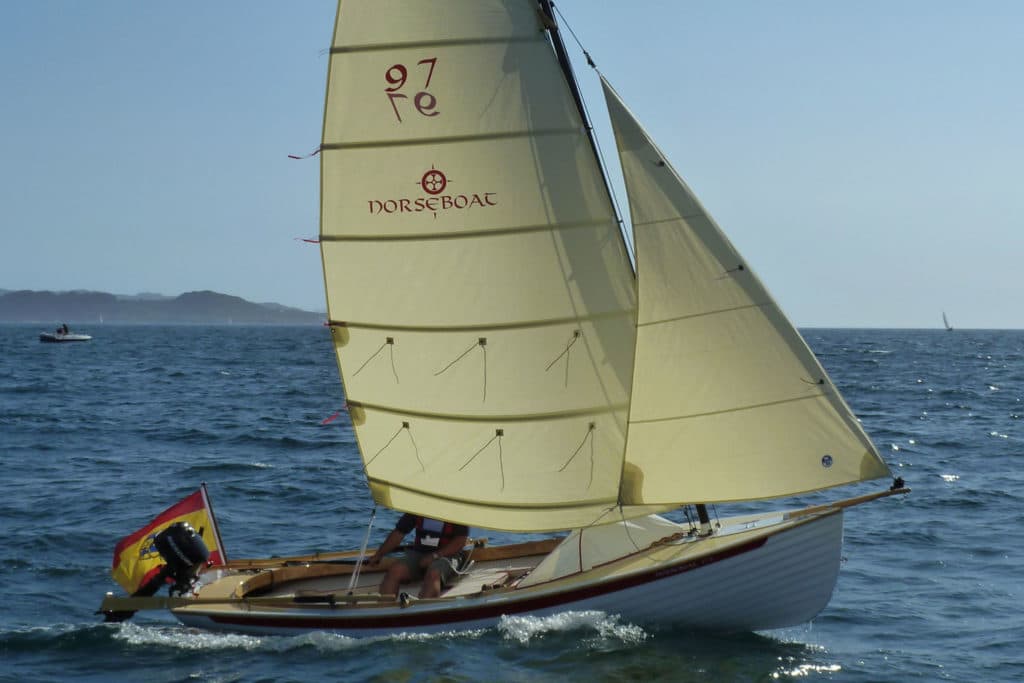
Designed for rowing and sailing (a motor mount is optional), the Canadian-built NorseBoat 17.5—one of which was spotted by a CW editor making its way through the Northwest Passage with a two-man crew—features an open cockpit, a carbon-fiber mast, and a curved-gaff rig, with an optional furling headsail set on a sprit. The lapstrake hull is fiberglass; the interior is ply and epoxy. The boat comes standard with two rowing stations and one set of 9-foot oars. The boat is designed with positive flotation and offers good load-carrying capacity, which you could put to use if you added the available canvas work and camping tent. NorseBoats offers a smaller sibling, the 12.5, as well; both are available in kit form.
$19,000, (902) 659-2790, norseboat.com
Montgomery 17
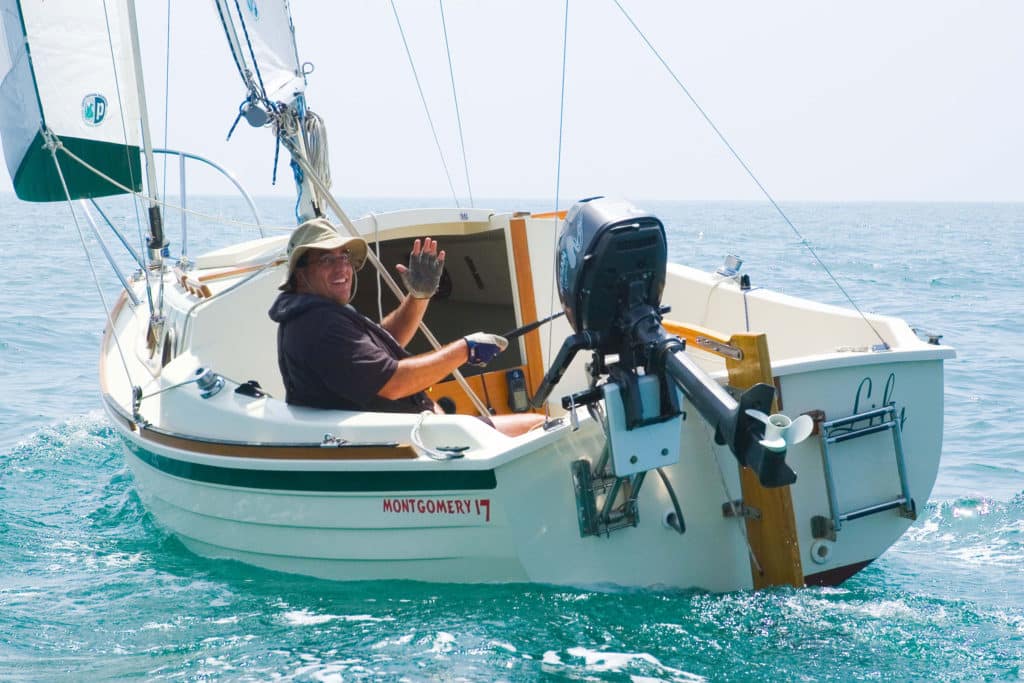
Billed as a trailerable pocket cruiser, the Montgomery 17 is a stout-looking sloop designed by Lyle Hess and built out of fiberglass in Ontario, California, by Montgomery Boats. With a keel and centerboard, the boat draws just under 2 feet with the board up and can be easily beached when you’re gunkholing. In the cuddy cabin you’ll find sitting headroom, a pair of bunks, a portable toilet, optional shore and DC power, and an impressive amount of storage space. The deck-stepped mast can be easily raised using a four-part tackle. The builder reports taking his own boat on trips across the Golfo de California and on visits to California’s coastal islands. Montgomery makes 15-foot and 23-foot models, as well. If you’re in search of a small sailboat with a cabin, the Montgomery 17 has to be on your wish list.
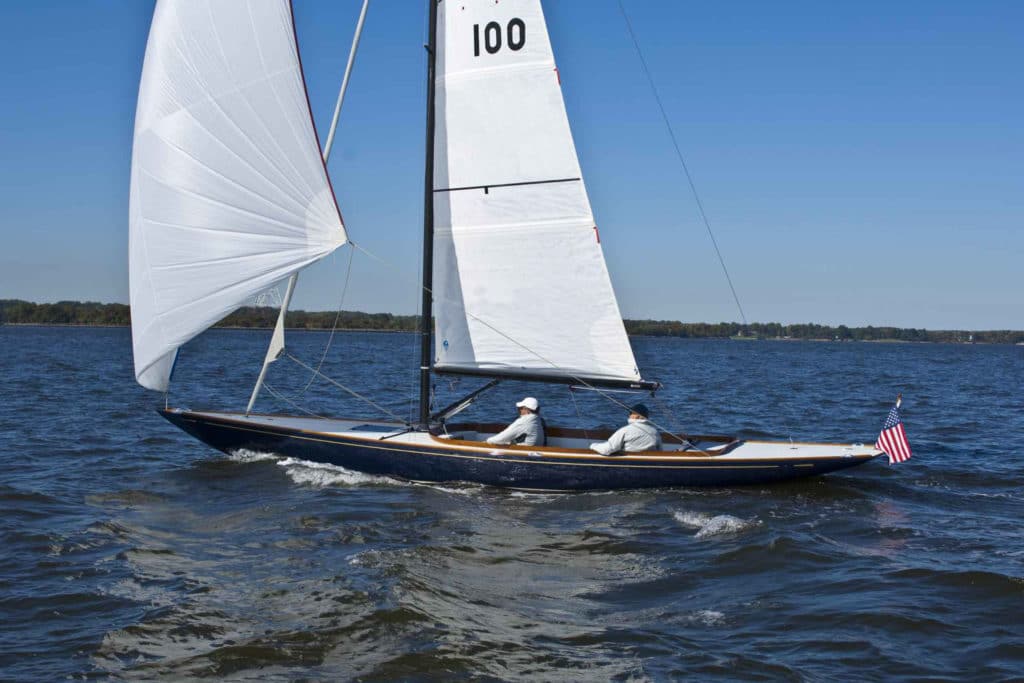
With long overhangs and shiny brightwork, the CW Hood 32 is on the larger end of the daysailer spectrum. Designers Chris Hood and Ben Stoddard made a conscious decision to forego a cabin and head in favor of an open cockpit big enough to bring 4 or 5 friends or family out for an afternoon on the water. The CW Hood 32 is sleek and graceful through the water and quick enough to do some racing, but keeps things simple with a self-tacking jib and controls that can be lead back to a single-handed skipper. A top-furling asymmetrical, electric sail drive and Torqeedo outboard are all optional. The CW Hood 32 makes for a great small family sailboat. cwhoodyachts.com
Sun Cat from Com-Pac
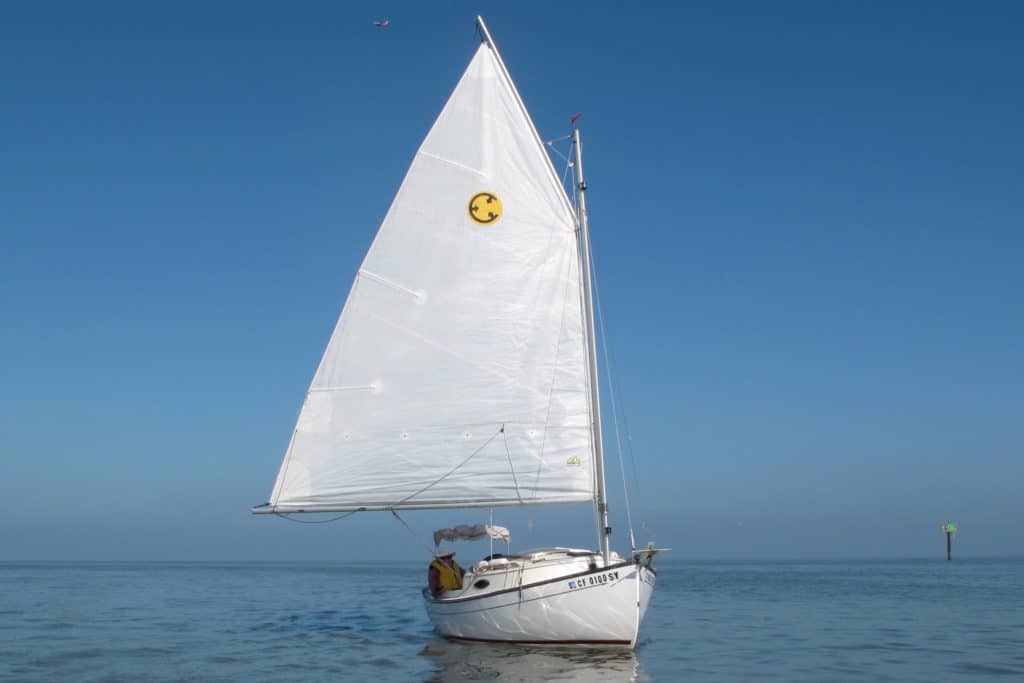
Shallow U.S. East Coast bays and rock-strewn coasts have long been graced by cat boats, whose large, gaff-rigged mainsails proved simple and powerful both on the wind and, better yet, when reaching and running. The 17-foot-4-inch Sun Cat, built by Com-Pac Yachts, updates the classic wooden cat with its fiberglass hull and deck and the easy-to-step Mastender Rigging System, which incorporates a hinged tabernacle to make stepping the mast a one-person job. If you want a personal sailboat ideal for solo sailing, the Sun Can is a great choice. Belowdecks, the twin 6-foot-5-inch berths and many other features and amenities make this cat a willing weekender.
$19,800, (727) 443-4408, com-pacyachts.com
Catalina 16.5
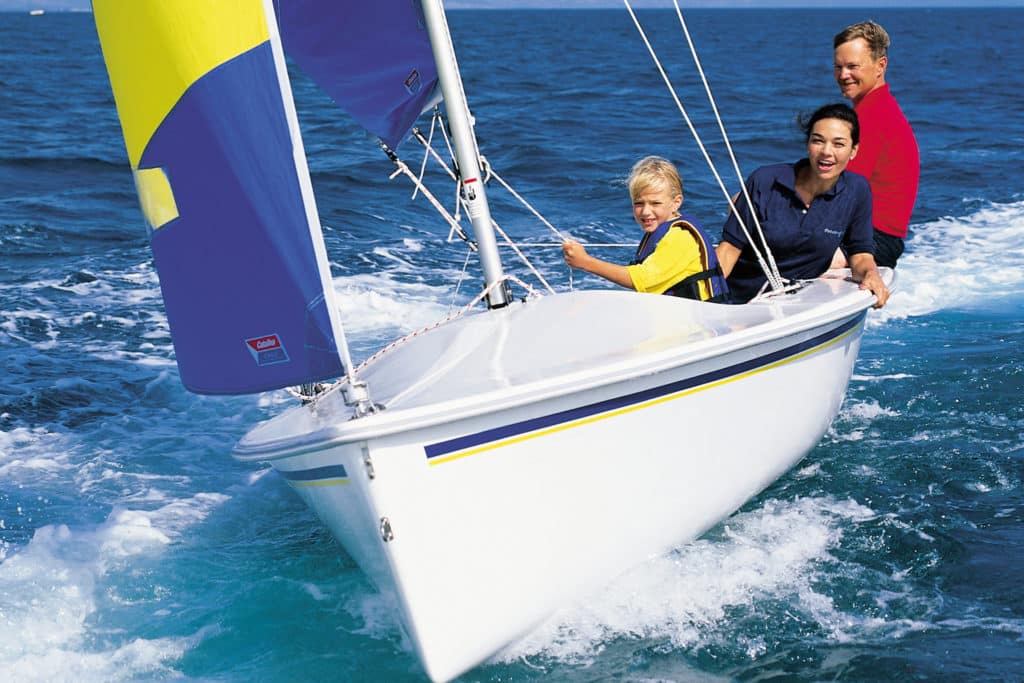
The Catalina 16.5 sits right in the middle of Catalina Yachts’ line of small sailboats, which range from the 12.5 to the 22 Capri and Sport, and it comes in both an easy-to-trailer centerboard model and a shoal-draft fixed-keel configuration. With the fiberglass board up, the 17-foot-2-inch boat draws just 5 inches of water; with the board down, the 4-foot-5-inch draft suggests good windward performance. Hull and deck are hand-laminated fiberglass. The roomy cockpit is self-bailing, and the bow harbors a good-sized storage area with a waterproof hatch. catalinayachts.com
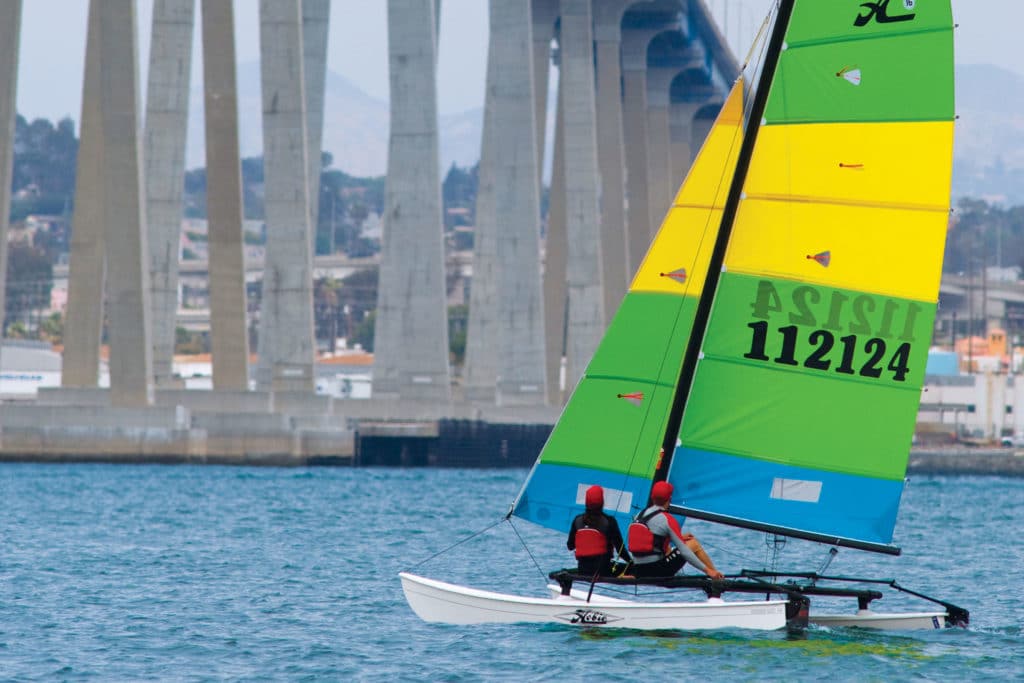
No roundup of best small sailboats (trailerable and fun too) would be complete without a mention of the venerable Hobie 16, which made its debut in Southern California way back in 1969. The company has introduced many other multihulls since, but more than 100,000 of the 16s have been launched, a remarkable figure. The Hobie’s asymmetric fiberglass-and-foam hulls eliminate the need for daggerboards, and with its kick-up rudders, the 16 can be sailed right up to the beach. Its large trampoline offers lots of space to move about or a good place to plant one’s feet when hanging off the double trapezes with a hull flying. The boat comes with a main and a jib; a spinnaker, douse kit, trailer, and beach dolly are optional features. hobiecat.com
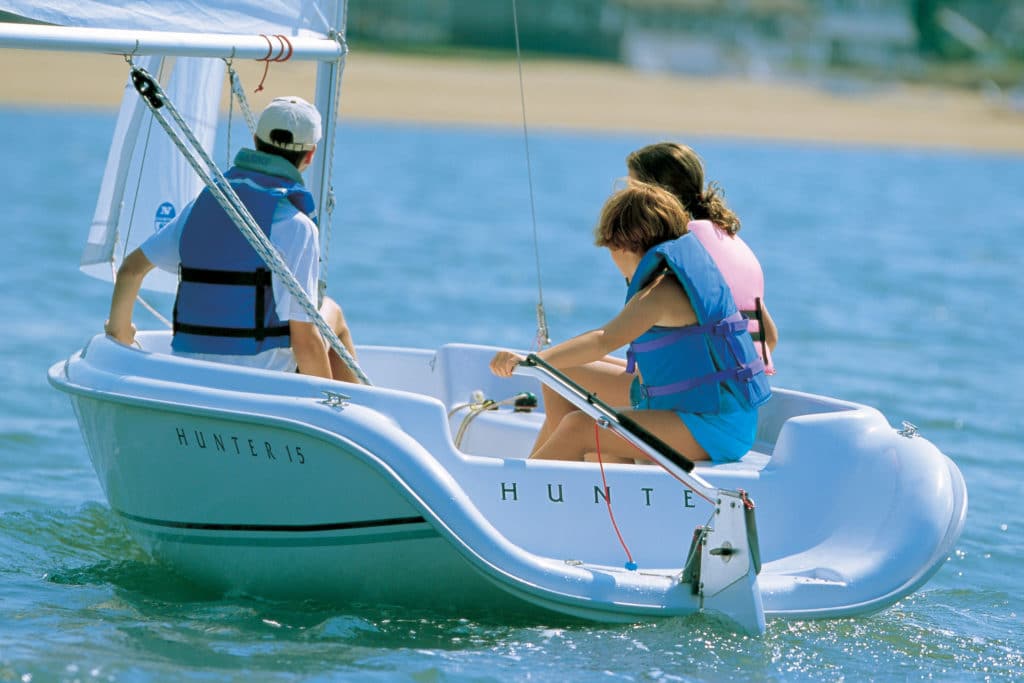
Novice sailors or old salts looking for simplicity could both enjoy sailing the Hunter 15. With a fiberglass hull and deck and foam flotation, the boat is sturdily built. The ample freeboard and wide beam provide stability under way, and the heavy-duty rubrail and kick-up rudder mean that you won’t have to worry when the dock looms or the going grows shallow. Both the 15 and its slightly larger 18-foot sibling come standard with roller-furling jibs.
$6,900/$9,500 (boat-show prices for the 15 and 18 includes trailers), (386) 462-3077, marlow-hunter.com
– CHECK THE FIT – Follow these guidelines to make sure your life jacket looks good, stays comfortable and works when you need it. Safety Tip Provided by the U.S. Coast Guard
Super Snark
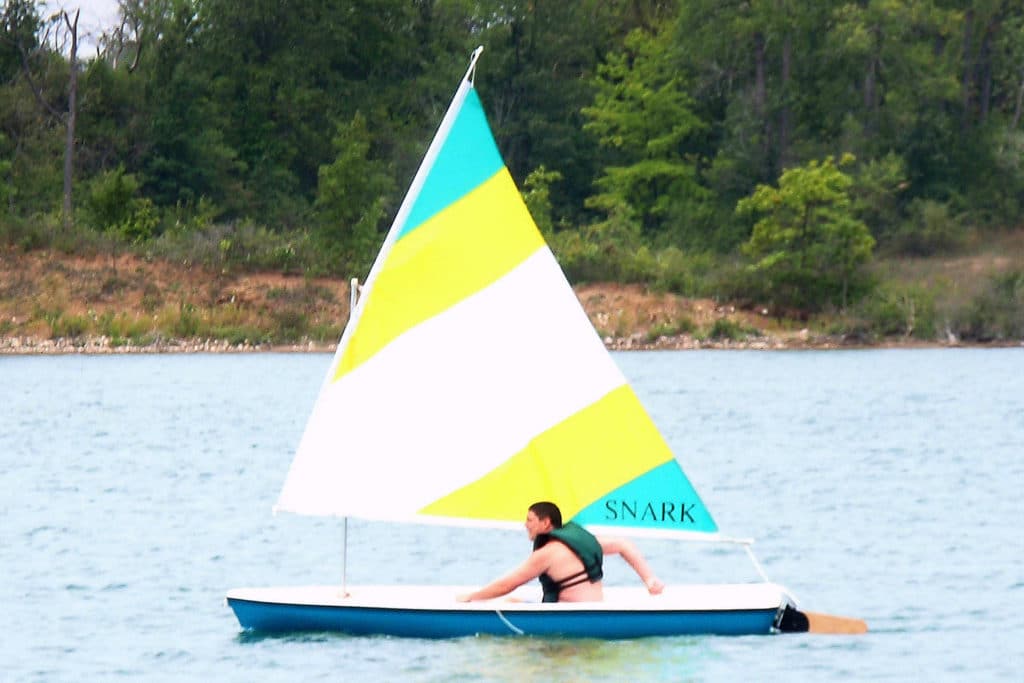
Under various owners, the Snark brand of sailboats, now built by Meyers Boat Co., has been around since the early 1970s. The Super Snark, at 11 feet, is a simple, easily car-topped daysailer that’s fit out with a lateen rig and sail. Billed as unsinkable, the five boats in the company’s line are built with E.P.S. foam, with the external hull and deck vacuum-formed to the core using an A.B.S. polymer. The Super Snark weighs in at 50 pounds, and with a payload capacity of 310 pounds, the boat can carry two.
$970, (800) 247-6275, meyersboat.com
Norseboat 21.5
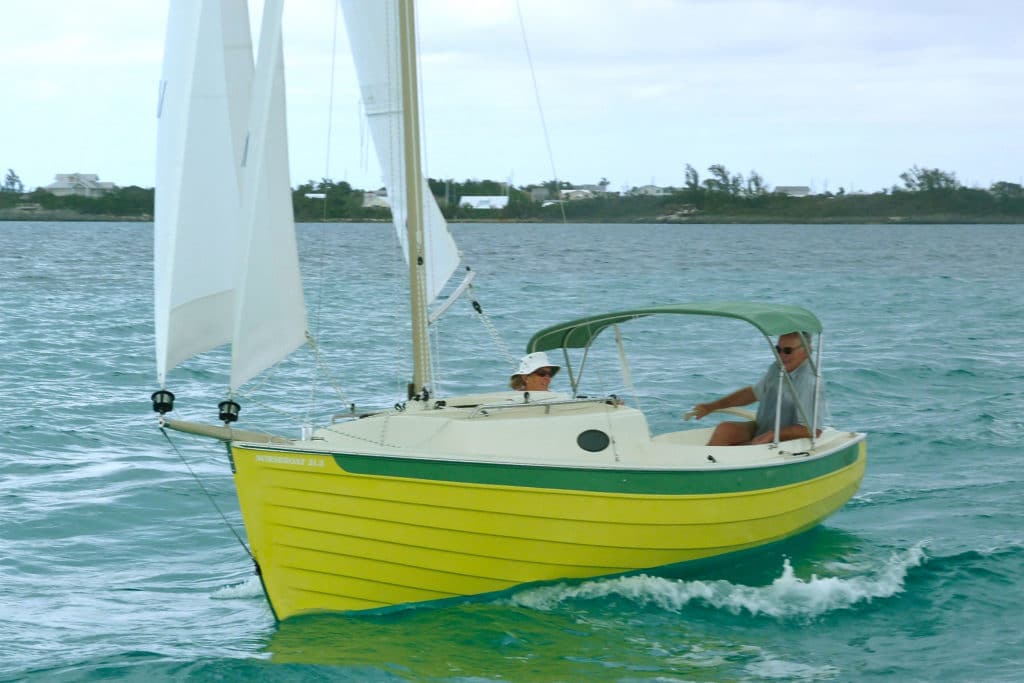
Built in Canada, the NorseBoat 21.5 is a rugged looking craft that comes in a couple of configurations: one with an open cockpit and small doghouse, and another with a smaller cockpit and cabin that houses a double berth for two adults and optional quarter berths for the kids. Both carry NorseBoat’s distinctive looking carbon fiber gaff-rigged mast with main and jib (a sprit-set drifter is optional), and come with a ballasted stub keel and centerboard. Because of its lightweight design, the boat can be rowed and is easily trailered.
$36,000 (starting), 902-659-2790, norseboat.com
Flying Scot
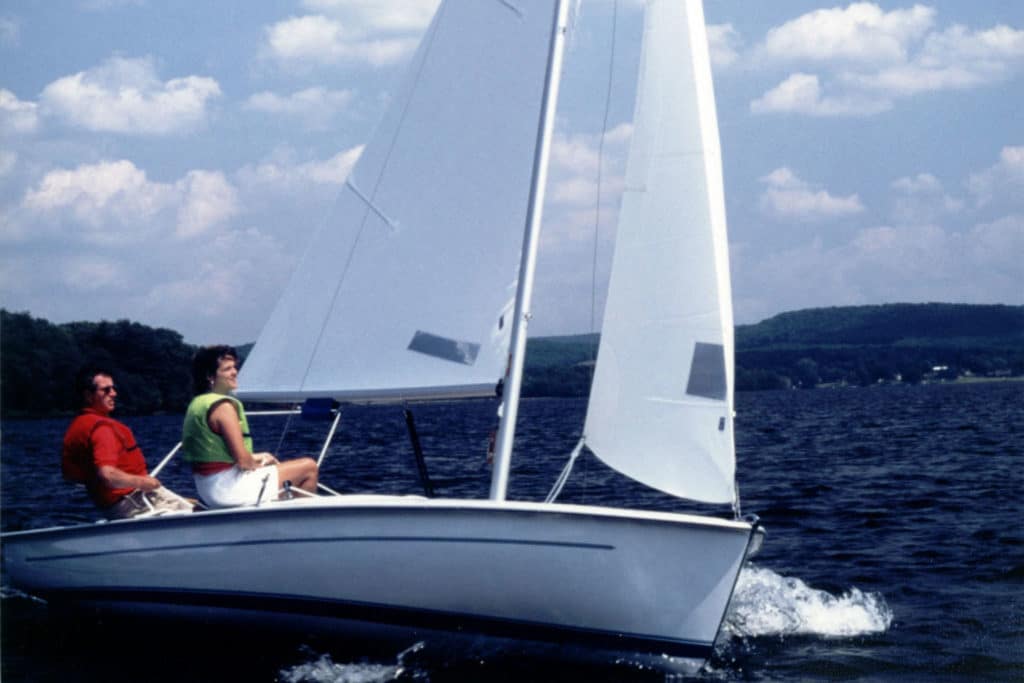
Talk about time-tested, the 19-foot Flying Scot has been in production since 1957 and remains a popular design today. Sloop rigged, with a conventional spinnaker for downwind work, the boat is an easily sailed family boat as well as a competitive racer, with over 130 racing fleets across the U.S. Its roomy cockpit can seat six to eight, though the boat is often sailed by a pair or solo. Hull and deck are a fiberglass and balsa core sandwich. With the centerboard up, the boat draws only eight inches. Though intended to be a daysailer, owners have rigged boom tents and berths for overnight trips, and one adventurous Scot sailor cruised his along inland waterways from Philadelphia to New Orleans.
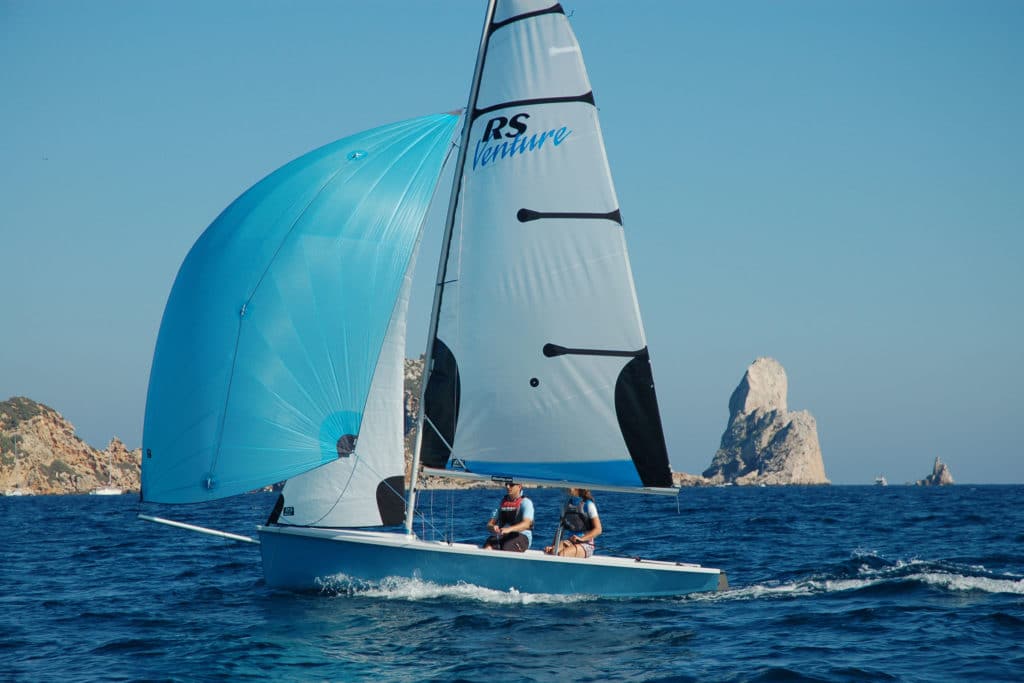
Known primarily for its line of racing dinghys, RS Sailing also builds the 16-foot, 4-inch Venture, which it describes as a cruising and training dinghy. The Venture features a large, self-draining cockpit that will accommodate a family or pack of kids. A furling jib and mainsail with slab reefing come standard with the boat; a gennaker and trapeze kit are options, as is an outboard motor mount and transom swim ladder. The deck and hull are laid up in a fiberglass and Coremat sandwich. The Venture’s designed to be both a good performer under sail, but also stable, making it a good boat for those learning the sport.
$14,900, 203-259-7808, rssailing.com
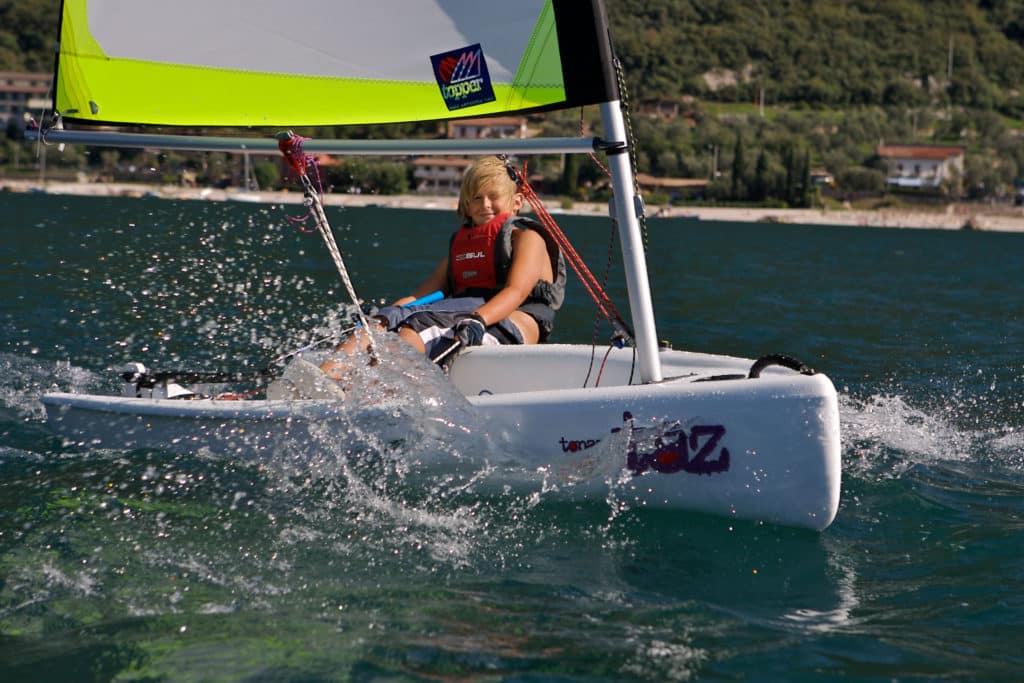
Topper makes a range of mono- and multihull rotomolded boats, but the model that caught one editor’s eye at Strictly Sail Chicago was the Topaz Taz. At 9 feet, 8 inches LOA and weighing in at 88 pounds, the Taz is not going to take the whole crowd out for the day. But, with the optional mainsail and jib package (main alone is for a single child), the Taz can carry two or three kids or an adult and one child, and would make a fun escape pod when tied behind the big boat and towed to some scenic harbor. The hull features Topper’s Trilam construction, a plastic and foam sandwich that creates a boat that’s stiff, light, and durable, and shouldn’t mind being dragged up on the beach when it’s time for a break.
$2,900 (includes main and jib), 410-286-1960, topazsailboats.com
WindRider WRTango
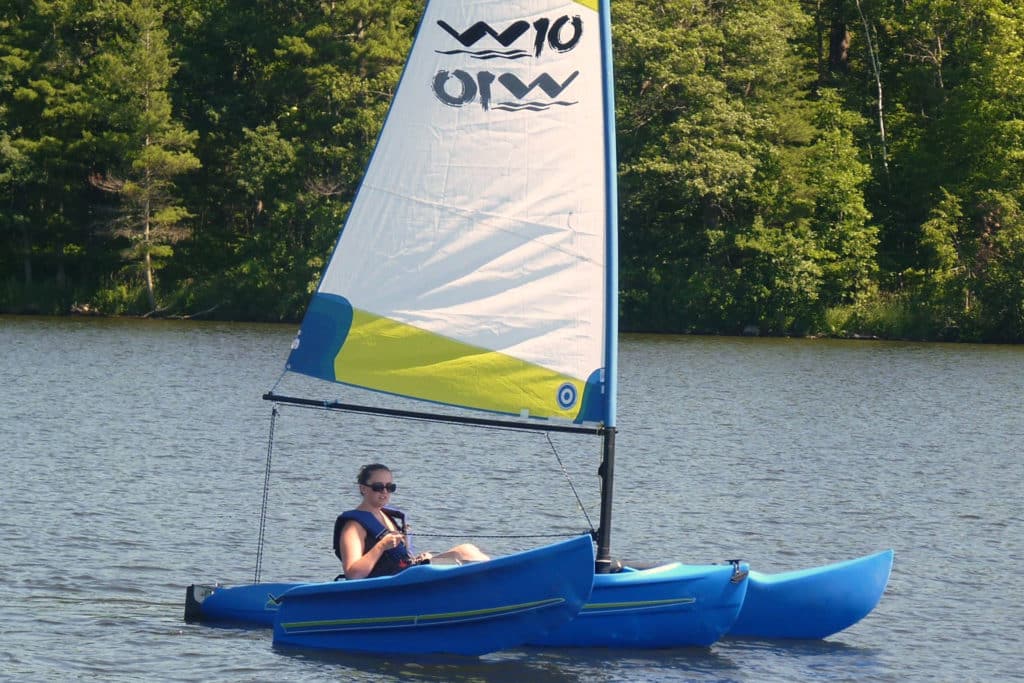
WRTango, a fast, sturdy, 10-foot trimaran that’s easy to sail, is the newest portable craft from WindRider International. It joins a line that includes the WR16 and WR17 trimarans. The Tango features forward-facing seating, foot-pedal steering, and a low center of gravity that mimics the sensation of sitting in a kayak. It weighs 125 pounds (including the outriggers and carbon-fiber mast), is extremely stable, and has single-sheet sail control. The six-inch draft and kick-up rudder make it great for beaching, while the hull and outriggers are made of rotomolded polyethylene, so it can withstand running into docks and being dragged over rocks.
$3,000, 612-338-2170, windrider.com
- More: 21 - 30 ft , Boat Gallery , day sailing , dinghy , Sailboat Reviews , Sailboats , under 20 ft
- More Sailboats

Sailboat Preview: Elan GT6 Explorer

For Sale: 1984 Camper & Nicholsons 58

Alubat Updates OVNI Models

For Sale: Little Harbor 63 Ketch
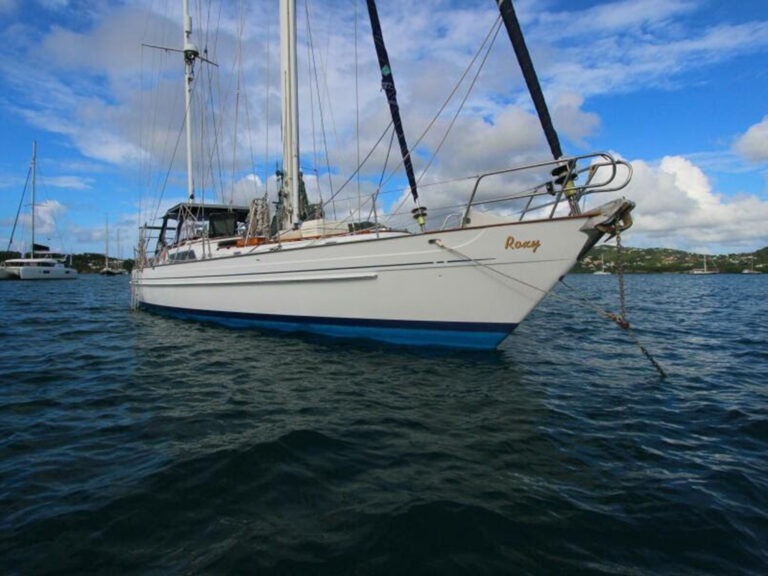
Sailing Avocet : A New Adventure Begins
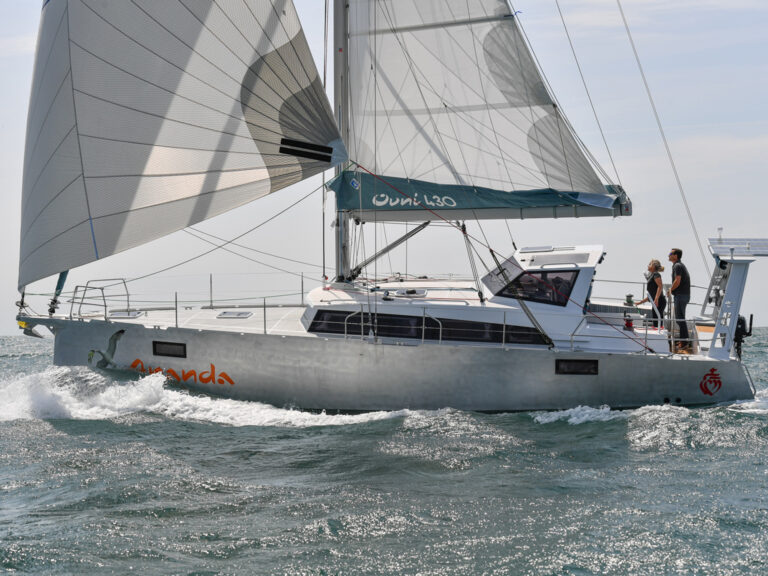
Options To Explore
- Digital Edition
- Customer Service
- Privacy Policy
- Terms of Use
- Email Newsletters
- Cruising World
- Sailing World
- Salt Water Sportsman
- Sport Fishing
- Wakeboarding
- Types of Sailboats
- Parts of a Sailboat
- Cruising Boats
- Small Sailboats
- Design Basics
- Sailboats under 30'
- Sailboats 30'-35
- Sailboats 35'-40'
- Sailboats 40'-45'
- Sailboats 45'-50'
- Sailboats 50'-55'
- Sailboats over 55'
- Masts & Spars
- Knots, Bends & Hitches
- The 12v Energy Equation
- Electronics & Instrumentation
- Build Your Own Boat
- Buying a Used Boat
- Choosing Accessories
- Living on a Boat
- Cruising Offshore
- Sailing in the Caribbean
- Anchoring Skills
- Sailing Authors & Their Writings
- Mary's Journal
- Nautical Terms
- Cruising Sailboats for Sale
- List your Boat for Sale Here!
- Used Sailing Equipment for Sale
- Sell Your Unwanted Gear
- Sailing eBooks: Download them here!
- Your Sailboats
- Your Sailing Stories
- Your Fishing Stories
- Advertising
- What's New?
- Chartering a Sailboat
- Ketch Sailboat
Does A Ketch Sailboat Make A Good Cruising Boat?
A ketch sailboat most certainly does make a good cruising boat! With the total sail area split between 3 sails (or 4 in the staysail ketch version shown below), sail handling is easier for a shorthanded crew than it would be on a sloop of similar size.
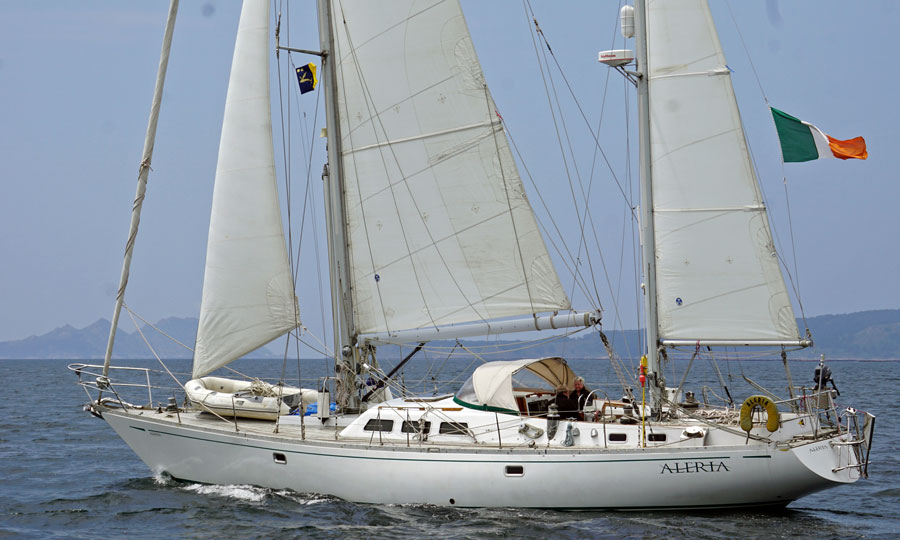
But could it be a Yawl?
It's easy to confuse a ketch sailboat with a yawl so perhaps we should clear that up before we go any further. Both are two-masted rigs with a mainmast foremost and a smaller mizzen mast aft.
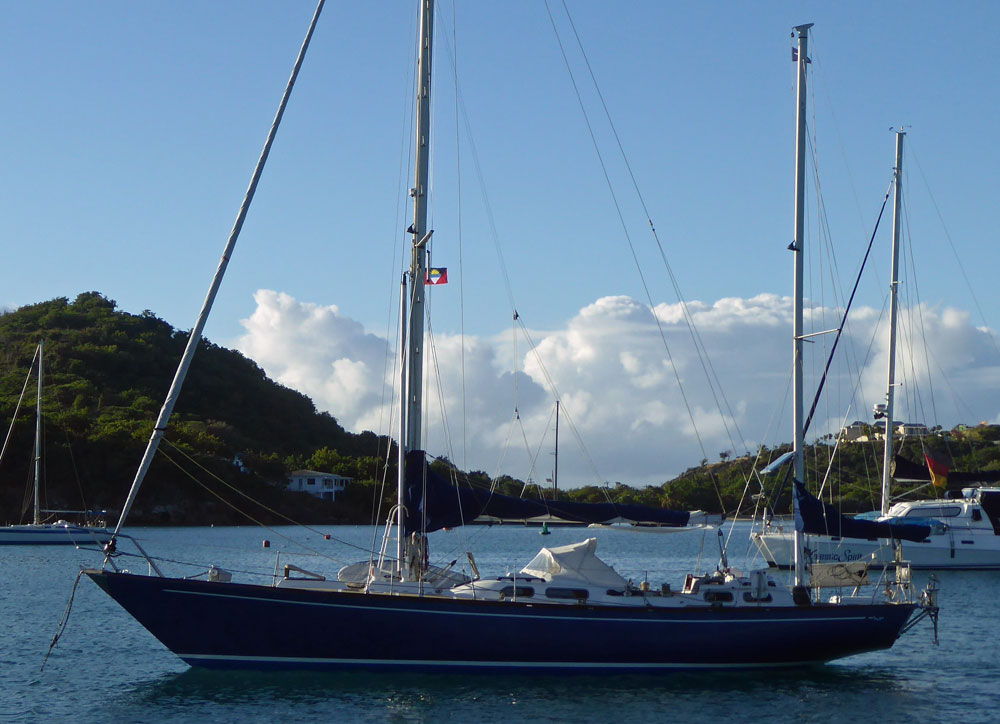
It's generally accepted that the difference between the two types comes down to the location of the mast in relation to the rudder post. In a yawl the mizzen is aft of the rudder post and in the ketch, it's forward.
But the real difference is one of purpose. The mizzen on a yawl is intended to help trim the boat, in capable hands giving them the ability to follow a compass course despite minor wind shifts.
This was a very handy feature in the days when commercial fishing was done under sail, but these days efficient autopilots and navigation aids have made this less important and the yawl has generally fallen out of favour.
| : Mizzen mast ahead of the rudder post | : Mizzen mast aft of the rudder post |
The Mizzen Sail on a Yawl or Ketch Sailboat
The mizzen sail of a ketch is larger than that of a yawl and is there to add drive. And so it does - off the wind.
On the wind though, the mizzen is likely to add nothing but drag, being back-winded most of the time by the mainsail.
In these conditions the mizzen sail may as well be dropped, at which point the ketch becomes in effect an under-canvassed sloop.
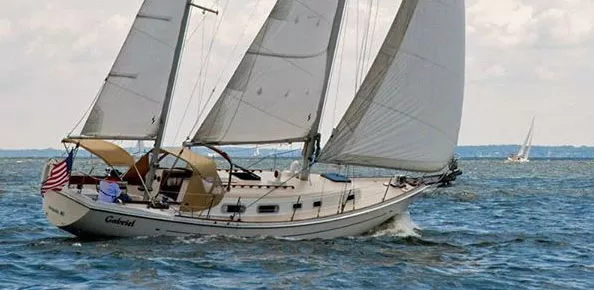
The Mizzen Staysail
Off the wind a ketch is at its most efficient, particularly so if cutter rigged and with a mizzen staysail set.
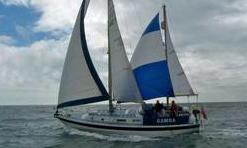
That's the sail set between the head of the mizzen mast and the foot of the main mast, as on the Westerly 33 shown here.
But all the additional hardware - mizzen mast, sails, winches, standing and running rigging - comes with a considerable cost burden.
But there are benefits to be had from a split rig of a ketch:~
- First, they offer greater flexibility for sail reduction, allowing a jib and mizzen configuration in strong winds;
- secondly, at anchor where with the mizzen set as a steadying sail, the boat will lay comfortably head-to-wind.
The Triatic Backstay
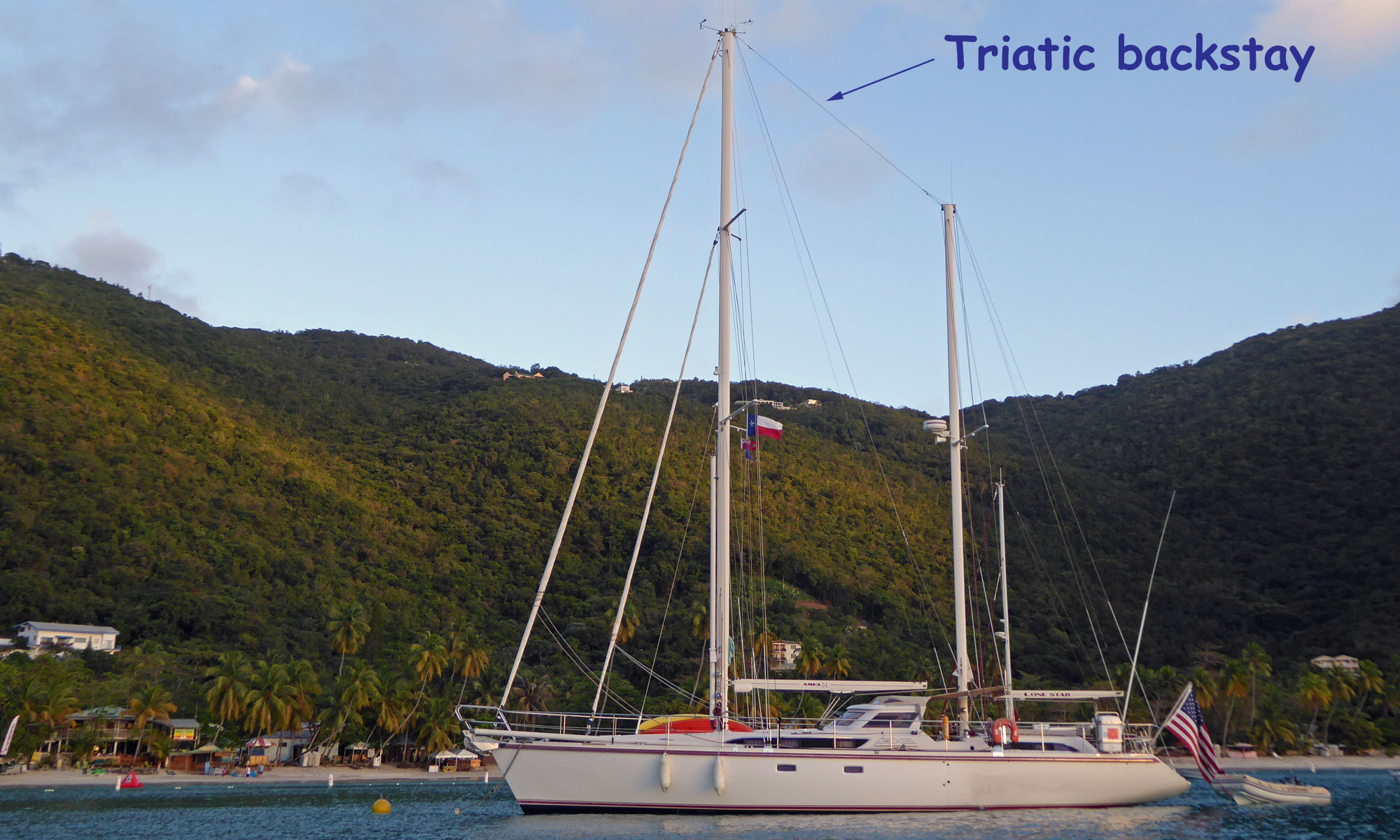
Although you'll see many ketch sailboats with a triatic backstay tensioned between the two mastheads, each mast should be stayed individually.
Whilst this stay is ideally placed to act as an insulated SSB radio aerial, in the event of the loss of one mast it's almost guaranteed to result in the loss of the other.
A staysail ketch like the Amel 54 shown above will carry the following suit of working sails:
- mizzen staysail;
A cruising sloop of a similar size has only two sails to make up the same sail area, which would be considerably more difficult for a short-handed crew to handle.
So, in answer to the original question, although they're not the best choice for windward sailing, the ketch can make an ideal cruising sailboat.
Lastly, the mizzen mast on a ketch sailboat provides an ideal place to mount your radar scanner and wind generator. And as one old sea-dog once told me, a convenient thing to lean against when you're smoking your pipe.
A Few Examples of Ketch Rigged Cruising Boats
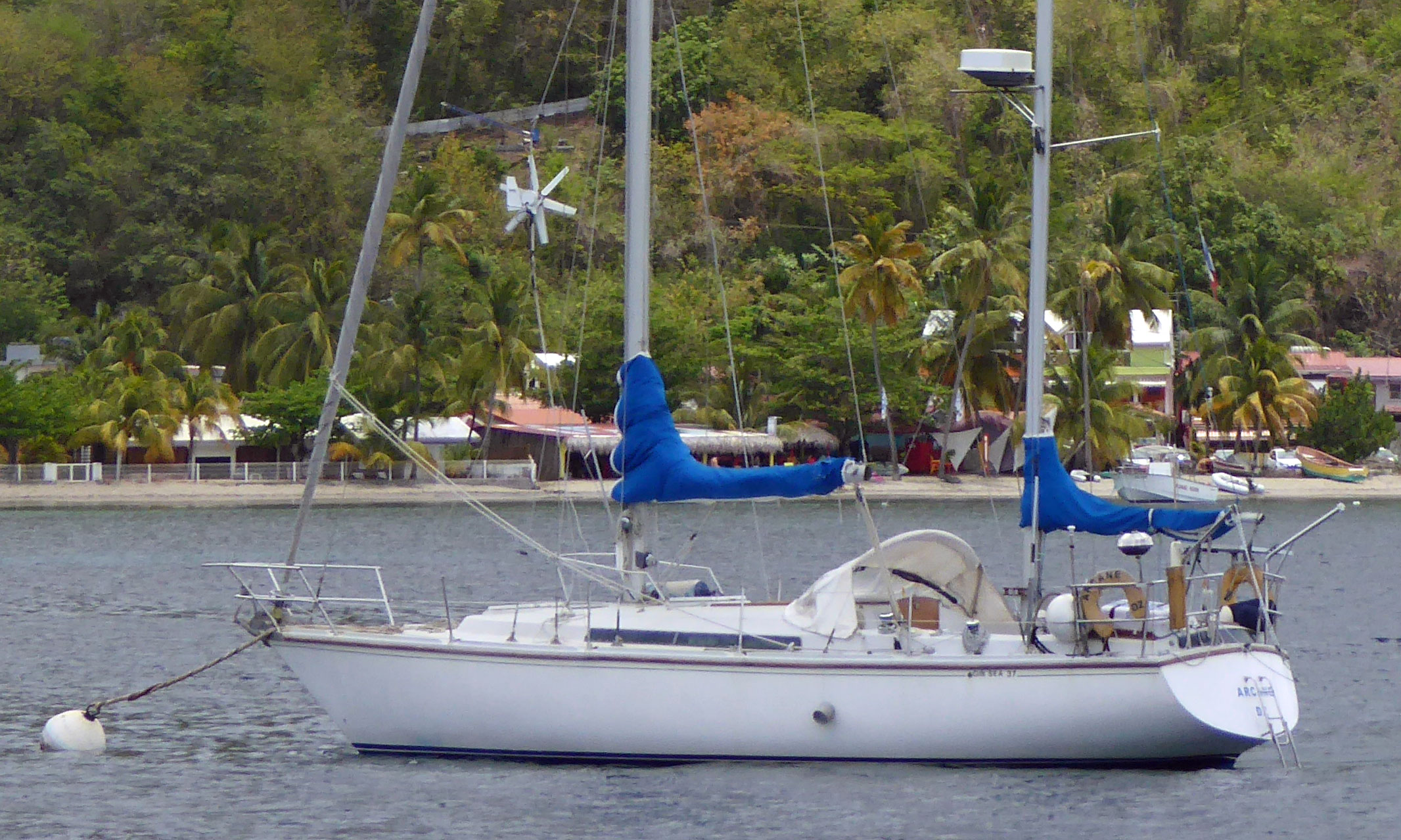
What are the Pros & Cons of a Ketch?
- Spread of Sail: Ketches have their sail area distributed over a higher number of sails, which means the size of each sail is generally smaller when compared to a sloop. This is useful when conditions are rough, as it's easier and safer to handle smaller sails.
- Rig Options: The ability to switch between sail configurations makes ketches versatile. You can use only the mizzen and jib in a strong wind, only the main in moderate wind, and all sails in a light wind.
- Downwind Efficiency: Ketches tend to perform well when sailing downwind, as the mizzen sail helps to catch additional wind.
- Balance: The mizzen sail aids in stabilizing the boat which is useful when minimizing roll at anchor and helps balance the boat under sail.
- Emergency Steering: The mizzen sail can be used for emergency steering if the rudder or main steering system becomes damaged.
- Cost: Ketches often cost more due to the additional rigging and hardware needed for the extra mast and extra sails.
- Maintenance: More rigging and more sails also mean more maintenance. Ketches may require more effort and cost to uphold.
- Windward Performance: Ketches are often outperformed by sloops or cutters when sailing upwind.
- Maneuverability: The extra mast can complicate tacking and jibing maneuvers, particularly in heavier winds.
- Space Occupancy: The mizzen mast in a ketch can limit the space available in the cockpit or aft areas.
It's important to note the pros and cons can vary based on the specific design of the ketch. Certain designs may mitigate some of the cons, and other pros may become more apparent in certain types of conditions.
What are the ideal sailing conditions and environments for a ketch sailboat?
Ketch sailboats are particularly suited for long-distance cruising and offshore sailing because of their stability, versatility in sail arrangements, and downwind performance. They perform best in moderate to heavy wind conditions where the additional mizzen sail can provide extra balance, power, and control.
These boats shine when sailing downwind or on reaches, where their additional sails can make full use of the wind. They also work well in heavy wind conditions where reducing sail area is necessary, as their multiple smaller sails can provide more manageable options.
In terms of environments, ketches tend to thrive in areas with consistent winds and open water, such as offshore or coastal cruising routes. Their stability and easy handling can be advantageous in rough sea states or when navigating rolling swells.
However, it's worth mentioning that the performance of a ketch can depend on the specific design of the boat, the skipper's sailing skills and the crew's ability to manage and adjust the sails on board.

Recent Articles
Nicholson 35 Sailboat Specs & Key Performance Indicators
Aug 24, 24 02:27 PM
Island Packet 37 Specs
Aug 23, 24 03:17 PM
Jeanneau Sun Odyssey 40 Specs
Aug 23, 24 04:18 AM
Here's where to:
- Find Used Sailboats for Sale...
- Find Used Sailing Gear for Sale...
- List your Sailboat for Sale...
- List your Used Sailing Gear...
Our eBooks...

Cruising Boats...
Our ever-growing gallery of pics and basic specifications of many popular cruising boats...
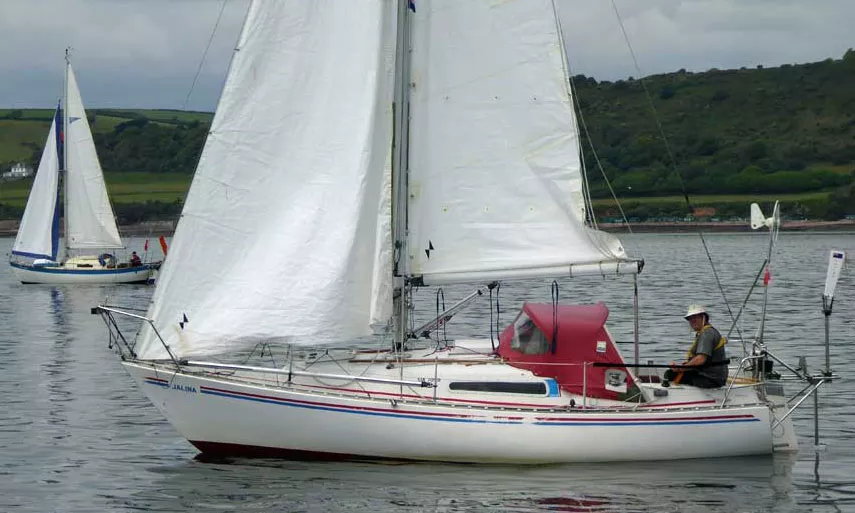
A few of our Most Popular Pages...

Copyright © 2024 Dick McClary Sailboat-Cruising.com



































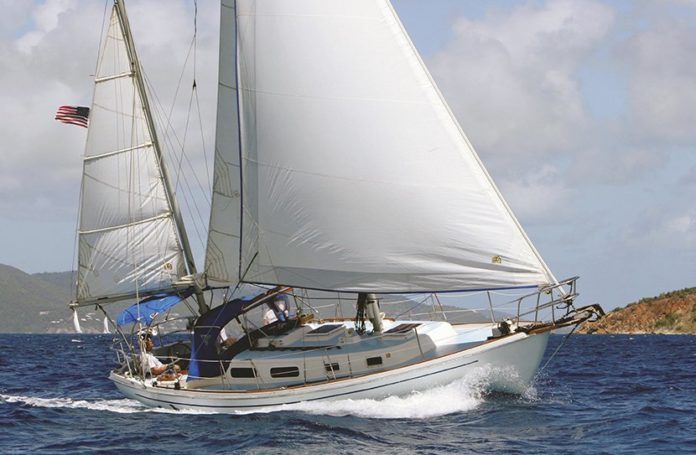









IMAGES
COMMENTS
Ketch sailing vessels pricing. Ketch sailing vessels for sale on YachtWorld are listed for a variety of prices from $13,400 on the relatively lower-priced, classic models all the way up to $16,361,933 for the more lavish boat models. Find Ketch boats for sale in your area & across the world on YachtWorld. Offering the best selection of boats to ...
Sailboat Reviews; Herreshoff Cat Ketch 31 ... In its original configuration (small sail plan/high displacement) the H-31s sail area/displacement ratio (SA/D) was an unremarkable 15.5, well below even the Freedom 40s 16.7. Given the changes (bigger sail plan/lighter displacement) the boats SA/D jumps to 19. ...
These sailboats have a minimum total sail area of 330 square feet, a maximum total sail area of 1,100 square feet and an average of 750 square feet. Boat Trader currently has 77 ketch sailboats for sale, including 4 new vessels and 73 used and custom yachts listed by both individuals and professional boat dealerships mainly in United States.
A ketch is a two-masted sailboat with a tall mizzenmast mast aft of the mainmast. A key characteristic of Ketch sailboats is that their mizzenmast is shorter than the mainmast. The mainmast itself is typical and resembles a sloop mast. A ketch has a mainsail and one or more headsails on the mainmast, along with a single mizzen on the mizzenmast.
Swan 65 ketch flying a spinnaker Fisher30 motorsailer ketch. A ketch is a two-masted sailboat whose mainmast is taller than the mizzen mast (or aft-mast), [1] and whose mizzen mast is stepped forward of the rudder post.The mizzen mast stepped forward of the rudder post is what distinguishes the ketch from a yawl, which has its mizzen mast stepped aft of its rudder post.
Ketch. Ideal for overnight cruising and day sailing these Ketch boats vary in length from 28ft to 152ft and can carry 6 to 39 passengers. There are a wide range of Ketch boats for sale from popular brands like Custom, Pearson and Gulfstar with 22 new and 411 used and an average price of $135,439 with boats ranging from as little as $11,406 and $15,095,358.
The ketch rig is an especially effective rig for larger boats (40ft and up). Just a quick recap: the ketch is a two-masted sailboat that has a mainmast (front) and shorter mizzenmast (aft or back). Both masts carry a mainsail. The sail on the mizzenmast is also called the jigger. Your mizzensail provides all kinds of benefits.
Swan 65. This is perhaps the most famed ketch rigged yacht of all time, a Sparkmans and Stephens design from an era when a state-of-the-art racing boat would also make a superbly comfortable cruising yacht. The model shot to fame in the first Whitbread Round the World Race (now the Volvo Ocean Race) in 1973/4.
Some examples of cat ketch sailboats are: The Freedom 40, designed by Gary Hoyt in 1977, was one of the first modern cat ketch sailboats. It has an aluminium mast forward and a carbon fibre mast aft, and can carry a small jib on a fractional forestay; The Herreshoff 31, designed by Halsey Herreshoff in 1979, is a classic cat ketch sailboat.
Find Ketch boats for sale in United States. Offering the best selection of boats to choose from.
The BayRaider is ketch-rigged with a gunter-style mainmast. The topmast and mizzen are both carbon-fiber, which is an option for the mainmast as well. The BayRaider can be sailed with a dry hull in lighter conditions or with 300 pounds of water ballast to increase its stability. ... No roundup of best small sailboats (trailerable and fun too ...
Small Sailboats; Design Basics; Pics, Data & KPIs. Sailboats under 30' Sailboats 30'-35; Sailboats 35'-40' Sailboats 40'-45' Sailboats 45'-50' Sailboats 50'-55' ... A ketch sailboat most certainly does make a good cruising boat! With the total sail area split between 3 sails (or 4 in the staysail ketch version shown below), sail handling is ...
Ketch sailing vessels pricing. Ketch sailing vessels for sale on YachtWorld are on offer for a variety of prices from £13,430 on the more modest side up to £16,084,830 for the more sophisticated yachts. Find Ketch boats for sale in your area & across the world on YachtWorld. Offering the best selection of boats to choose from.
The ketch is a traditional sailing vessel that has its origins in Holland. It was originally used as a fishing boat, but was later adapted for use as a pleasure craft. The ketch is characterized by its two masts, with the main mast being taller than the aft mast. The sails are also asymmetrical, with the mainsail being larger than the headsail.
31' Mariner Ketch - Major Restoration & Repower - New Rigging & Sails Tenants Harbor Maine, Maine Asking $45,000
A ketch is a type of sailboat that has two masts, with a smaller mast located at the stern. The smaller mast is known as the mizzenmast, and it is usually smaller than the main mast. Ketch sailing is a popular activity among avid sailors, as it offers a range of benefits, including improved stability, increased speed, and excellent maneuverability.
1990 Irwin 54 Ketch. $245,000. ↓ Price Drop. Merritt Island, FL 32952 | Private Seller
Impress your sloop-sailing friends with fancy ketch tricks. Sail backward through the mooring field (spin circles if you have a sharpie), nose casually up to anchor, hove-to with jig and jigger. Barrel westward on a reach. Turbo-charge off-wind sailing by setting a mizzen staysail. Don't fear a dismasting.
Ketch sail boats for sale 426 Boats Available. Currency $ - USD - US Dollar Sort Sort Order List View Gallery View Submit. Advertisement. Save This Boat. Mason 53 . Florida. 1983. $264,000 (Sale Pending) Seller Able Yacht Brokerage 22. Contact. 781-546-5229. ×. Save This Boat. Dickerson 37 Ketch . Pine Beach, New Jersey ...
Ketch. Currently, Ketch, a yacht builder has 6 yachts available for purchase on YachtWorld. This collection encompasses 1 newly built vessels as well as 5 pre-owned yachts, with all listings, handled by boat and yacht brokers, primarily concentrated in Turkey, Denmark, United States and South Africa.
These sailboats have a minimum total sail area of 211 square feet, a maximum total sail area of 1,080 square feet and an average of 490 square feet. Boat Trader currently has 24 pilothouse sailboats for sale, including 1 new vessels and 23 used and custom yachts listed by both individual owners and professional boat dealerships mainly in United ...
Make Morgan Outislander 41. Model 415 Ketch. Category Sloop Sailboats. Length 41. Posted Over 1 Month. 1980 $1 ft Morgan Outislander 415 Ketch rigged sailboat, Includes a private mooring and private dingy dock with a 12 ft hard dingy, center consul and auto start.
For some reason, however, this conceit survived much longer than it should have. As late as the 1970s, and even into the early 1980s, many believed a ketch rig was best for cruising and such rigs were sometimes seen on boats as small as 30 feet. As late as the early 1990s, ketch rigs were also favored on large maxi ocean racers.